THURSDAY
JANUARY 31 - 2013
The
first Bumblebee in 2013
Brian Lawrence was
walking at Prinsted today when he spotted a Bumblebee
with full pollen baskets on Gorse flowers. From the
single yellow bands on thorax and abdomen and white
tail, plus the pollen baskets, I think this must be a
worker Buff-tail (Bombus terrestris). See . . .
http://bumblebeeconservation.org/about-bees/identification/common-bumblebees/
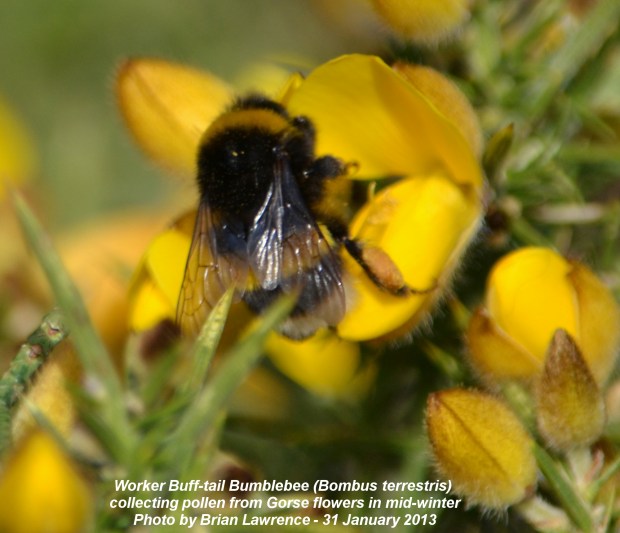
Bryan Pinchen alerted
us to expect to see these Bumblebees in mild winters.
Queens of B. terrestris start nesting in the autumn
and, if the weather is mild, continue throughout the
winter producing workers and later, males and new
queens. This was the first Bumblebee I have seen
reported locally this winter.
Yet more Water Voles
This morning, Maurice
Lillie saw two Water Voles feeding between 25 and 30
metres south of the S-bend on the Ems. A little later
Maurice saw one vole climb onto a branch and walk up
to the other vole whereupon, in his words, 'they gave
a good impression of kissing briefly or perhaps it was
a sniff by two very short sighted animals. As they did
not fight, I think it reasonable to assume that they
are a pair'. This takes the total number of sightings
for 2013 to 19. While Maurice was watching for Water
Voles he also saw a Firecrest on the river bank close
to the S-bend.
Firecrest
is till on Brook Meadow
I met up with Malcolm
Phillips at the observation fence in Palmer's Road
Copse this morning. We both had a very good view of
the Firecrest moving around in the tangle of bushes to
the south of the fence. Malcolm thinks this is where
the bird probably roosts at night as it is dense and
well covered in Ivy leaves.
Sweet
Violets flowering
There are now a good
number of Sweet Violets open on the Lillywhite's path
wayside. This flower caught my attention as it appears
to have both violet and white petals. White forms of
Sweet Violets are common on this wayside, but I don't
recall having seen a plant with both.
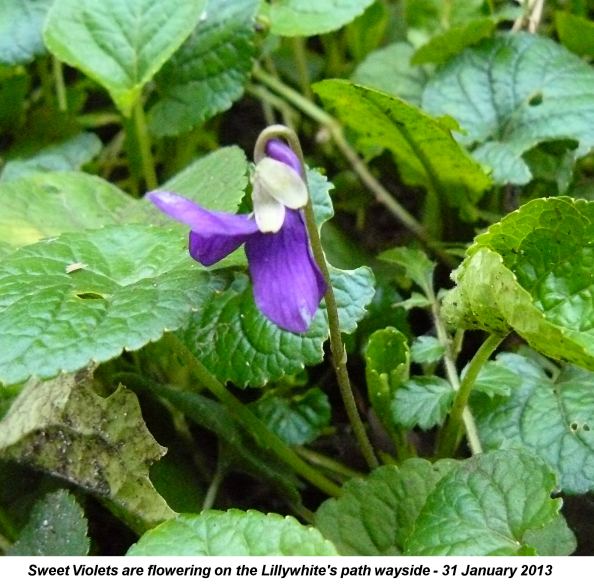
Hairy
Garlic
Four plants of Hairy
Garlic are showing well at the eastern end of the
Lillywhite's path wayside, all with fresh leaves. They
are much better specimens than the Hairy Garlic I saw
in Nore Barn Woods yesterday.

Hairy Garlic
(Allium subhirsutum) is a rare garden escape,
probably overlooked in recording. It is a
Mediterranean species with a scattering of broad, more
or less prostrate, shiny green leaves, with slightly
hairy edges, from which the plant gets its common
name. Its leaves give off a faintly garlic aroma when
crushed.
More
Lesser Celandines
Following the
discovery of the first Lesser Celandine on Brook
Meadow yesterday, Tony Wootton found some more out on
the roadside verge in Lumley Road and in the flower
tubs of the Kings Arms pub on the Havant Road. This
takes the January flowering plant list to 36 species.
See complete list at . . . Winter
flowering plants
A
wall Lichen
There is a rather fine
growth of yellow lichen on the brick wall of one of
the gardens in Lumley Road. I don't know what species
this is, but I see it around quite a lot.
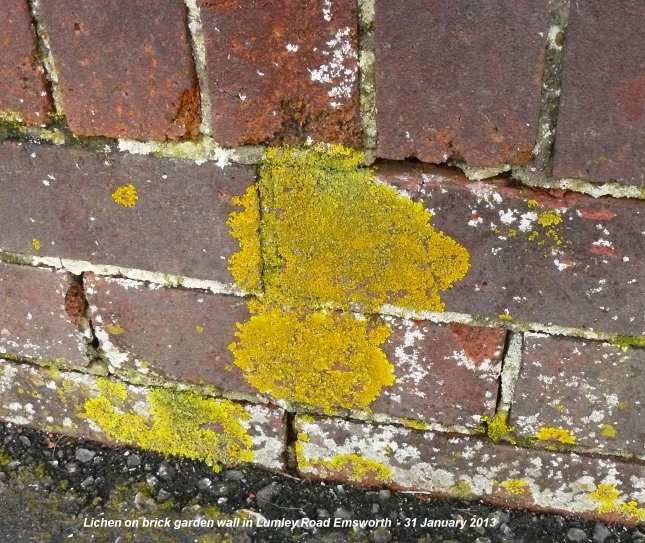
Lumley
Mill sluice
All three gates have
been removed from the Lumley Mill sluice and the water
is rushing down into the Lumley Stream like a torrent.
I last looked at the gate on Dec 16 when only the
centre gate was out.
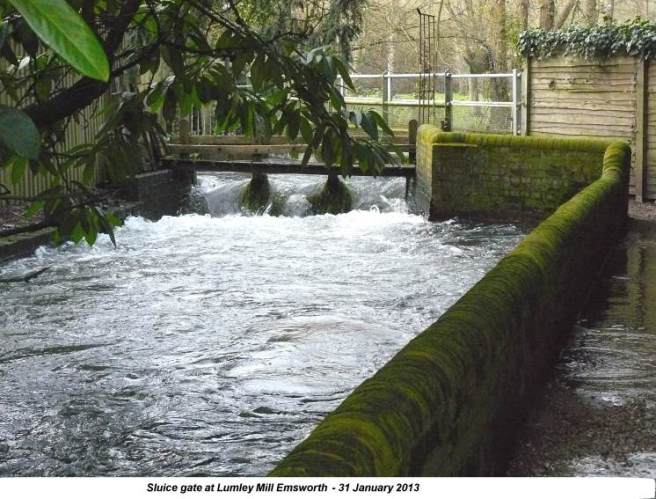
WEDNESDAY
JANUARY 30 - 2013
NORE
BARN
10:00 - 12:00 Tide
rising to high water at 13:13.
Two
Spotted Redshanks
I had a real struggle
to get along Western Parade this morning against the
gale force westerly wind with frequent squally
showers. I almost gave up, but pleased I did not as
when I eventually reached Nore Barn at about 10:15 the
sun was shining and two Spotted Redshanks were in the
lower stream to greet me!

I watched these two
birds for about 15 minutes feeding fairly close
together with no signs of any antagonism. They
eventually separated with, what I assume was the
'resident' bird moving into the rapidly filling
stream, and the 'visitor' settling on the point at the
edge of the saltmarshes.
Later on in the
morning Ralph Hollins, Brian Lawrence and I had some
excellent close-up views of the 'resident' Spotted
Redshank as it was gradually pushed further up the
stream and closer to the small bridge by the incoming
tide. The bird gradually came closer to where I was
standing, exploring the small channels made by the
flood waters from the fields.
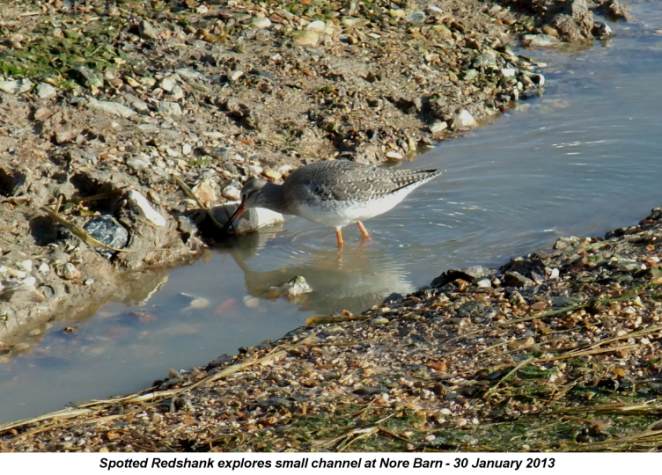
I stayed on for until
12 noon during which time there was a constant stream
of people passing within yards of where the Spotted
Redshank was feeding, many with dogs off the leads.
Never once did the bird show any signs of concern and
certainly did not fly away. Fortunately, none of the
dogs went into the stream, which would have disturbed
the bird.
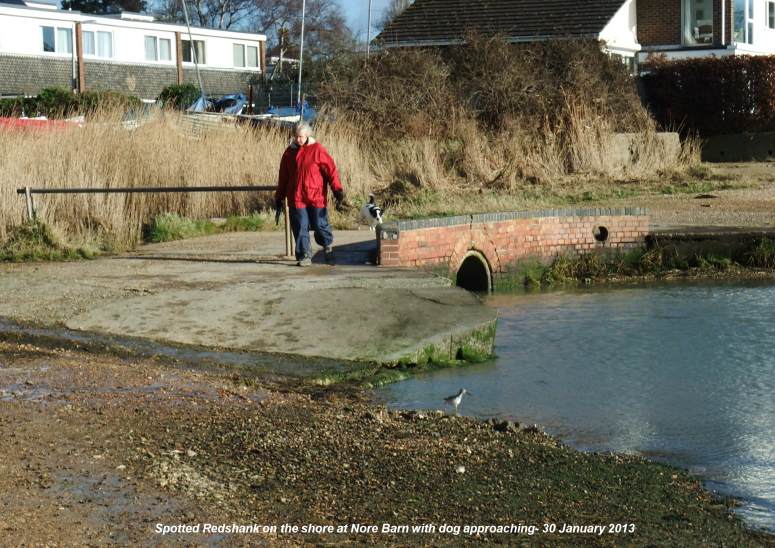
Brent
Geese
I made my way to the
creek south of the woods where I knew I would be
sheltered from the westerly wind. I settled down on
the seat to have coffee and look through a group of 38
Brent Geese that were feeding on the mudflats fairly
close to the shore. The group included two of our
regular Brent families with two juveniles each. The
youngsters have now acquired their white neck bands,
but the white bars on their wings still distinguishes
them as juveniles.
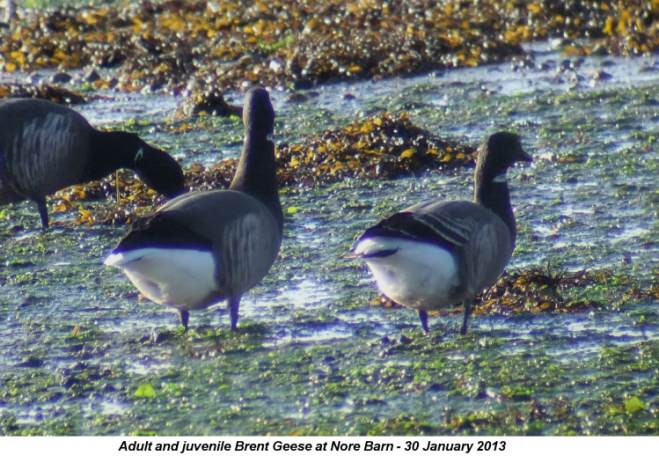
Other
birds
The Nore Barn Creek
was full of Wigeon and Teal creating a constant
soft whistling sound with their calls, mixed in with
the gentle kerunking of the Brents. There were a
couple of Common Redshanks on the edge of the
saltmarshes, but no sign of any Greenshanks like we
used to have a few years ago. Come to think of it, I
see very few Greenshanks in the harbour these days.
On my way along
Western Parade a man I often speak to about birds
stopped to inform me that yesterday he had seen a pair
of Goldeneye in the main eastern channel near
the wooden jetty. This is the first Goldeneye sighting
we have had in Emsworth Harbour this winter and
probably the first for several years. Maybe they were
blown in by the wind?
Lichen
At the head of the
creek I met Ralph Hollins who had walked along the
shore from Warblington. Together we inspected and
admired the lichen that was growing in some abundance
on the bushes along the shore south of Nore Barn
Woods.
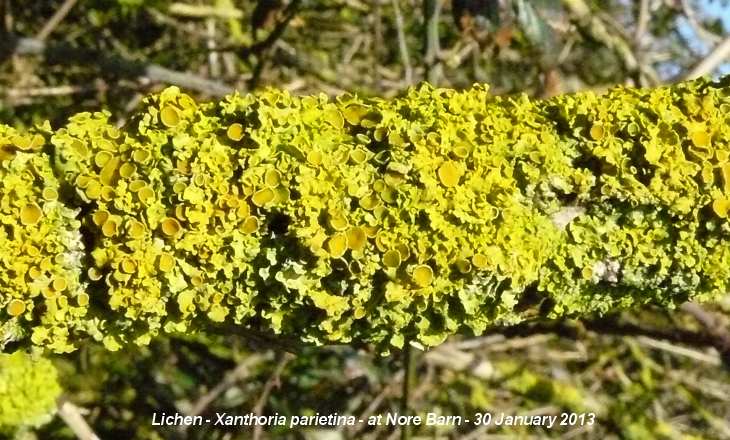
We are fairly sure the
yellow-lime lichen on the Blackthorn twigs is
Xanthoria parietina which I also found on twigs near
Peter Pond yesterday. We also found some bright orange
lichen which under the microscope look like the
fruiting bodies, probably also of Xanthoria parietina.
There was also a lot of grey lichen which looked
rather like a dead version of Xanthoria parietina. I
think the yellow lichen was on live twigs and the grey
lichen on dead twigs. See Wikipedia on this lichen . .
. http://en.wikipedia.org/wiki/Xanthoria_parietina
"Xanthoria parietina
is a foliose, or leafy, lichen. It has wide
distribution, and many common names such as common
orange lichen, yellow scale, maritime sunburst lichen
and shore lichen. It can be found near the shore on
rocks or walls (hence the epithet parietina meaning
"on walls"), and also on inland rocks, walls, or tree
bark. The lichen pigment parietin gives this species a
deep yellow or orange-red colour."
Hairy
Garlic
I found some fresh
leaves of the Hairy Garlic that grows on the path
north of Nore Barn Woods. However, the plant seems to
have taken quite a battering, partly from the weather
and partly from the clearing activity along this path,
with the result there are far fewer leaves than usual.
Ralph found fresh
leaves of English Scurvygrass on the saltmarshes.
Red
Admiral
I was hoping to see a
Red Admiral in the warm sunshine on the shore at Nore
Barn this morning, but no such luck. However, when I
got home my wife told me she was sure she had seen a
butterfly - probably Red Admiral - flying in the
garden. Then, I had an e-mail from Wally Osborne to
say that around midday today he did see a Red Admiral
in his garden, fighting against the gusty wind but
clearly enjoying the warm sunshine. These were the
first butterflies of 2013.
BROOK
MEADOW
Water
Voles
Malcolm Phillips went
round the meadow this afternoon and at about 12.30pm
saw a Water Vole by the gas holder. He was not quick
enough to get a photo as the vole dived under the
brambles. Malcolm saw another Water Vole by the 'deep
water' sign in Palmer's Road Copse at 1.45pm. He
watched it swim towards the observation fence and
managed to get a photo.
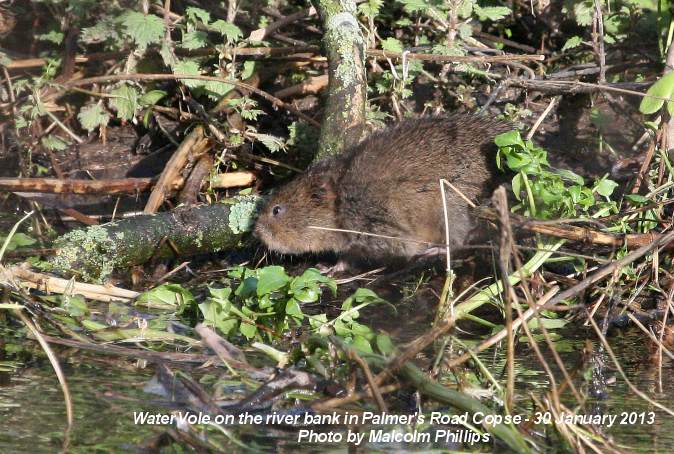
Firecrest
While Malcolm was
standing at the observation fence the Firecrest flew
in and got his photo taken. Malcolm also heard the
Water Rail but did not see it.

Lesser
Celandine
Malcolm had the honour
of finding the first Lesser Celandine flower on Brook
Meadow for this year. This is the first in Emsworth as
far as I know, though Ralph Hollins has been seeing
plenty open in the Havant area.
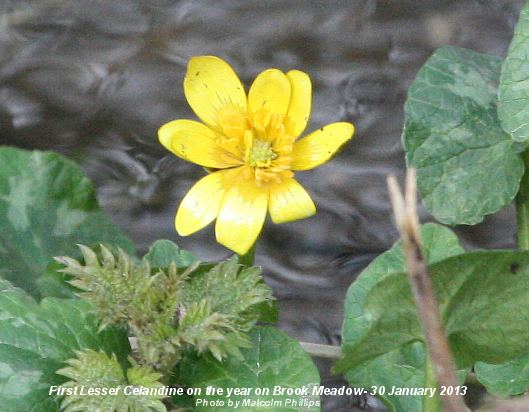
TUESDAY
JANUARY 29 - 2013
Mute
Swan intruder
I passed by Peter Pond
on the way to the shops this morning and noticed three
Mute Swans walking up Lumley Road dodging the traffic
Two of the swans were the residents that will be
nesting here, but the other one was an unwelcome
intruder. The hapless intruder was pursued onto the
pond, presumably by the cob of the resident pair, and
relentlessly chased. As it was tipping down with rain
I did not stay to see the conclusion of the dispute,
but clearly, the resident pair are now strongly
territorial and will not tolerate the presence of
other swans on their patch. Things can get rather
nasty if the intruder resists too much.
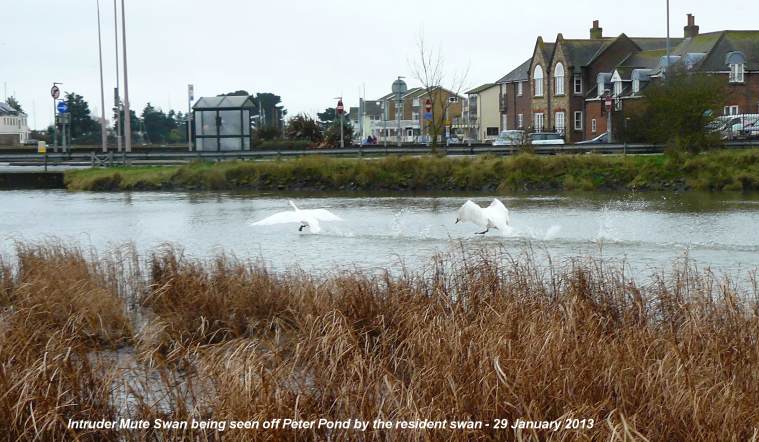
Lichen
on twig
I broke off a small
twig from a Blackthorn bush on Peter Pond which had a
healthy growth of lime green lichen on it. The lichen
has flat broad lobes and many cup-shaped
spore-producing bodies which show up clearly under the
microscope. It reminded me of a moonscape. My
calculated guess is that it is Xanthoria
parietina which is said to be very common on
rocks, walls, trees, etc. A lichen is usually
described as a thallus, not as a plant. It is a
composite organism consisting of a fungus and an alga
living in a symbiotic relationship.
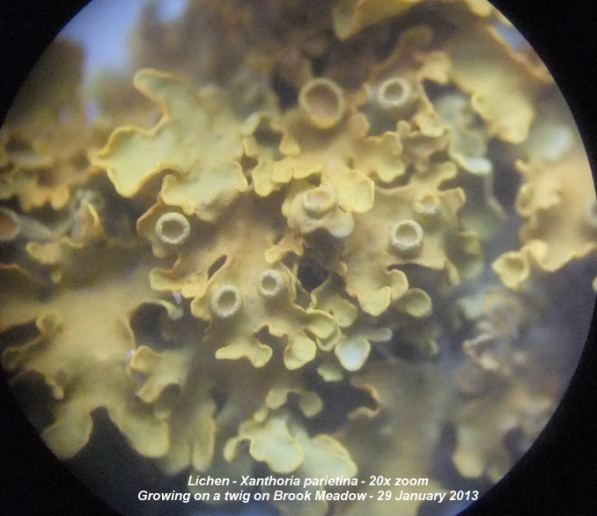
I now
have a special page devoted to news and observations
of lichen . . .
Lichen
Cuban
memories
The weather was not
good for photography, so Malcolm declined the joys of
Brook Meadow for once and recalled the sunnier and
warmer times he had while on holiday in Cuba. Here is
Malcolm's picture of a Cuban Emerald Hummingbird
homing in on some nectar.
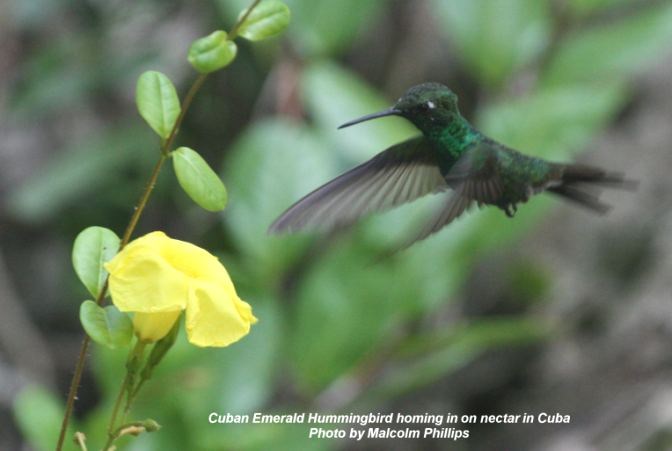
Red-breasted
Goose
Yesterday (Jan 28)
Owen Mitchell found a flock of 500-600 Brent Geese on
the flooded field at Eames Farm, including a
Red-breasted Goose and a Pale-bellied Brent. This is
probably the same Red-breasted Goose that was at
Farlington Marshes for some months at the end of last
year and has now moved across the border into Sussex.
It was seen on Thorney Island by Barry Collins on Jan
27. This photo of probably the same Red-breasted Goose
was taken by Peter Milinets-Raby Portsmouth on 10
December 2012.

Giant
Butterbur
Ralph Hollins found
the Giant Butterbur (Petasites
japonicus) now in flower on the 'No Man's
Land' alongside the Langbrook Stream before reaching
the track into the old Langstone Dairy Farm. Ralph
says there was a good show of fresh leaves (only) of
the female Butterbur also. This flowers later, like
the (all male) Butterbur we have on Brook Meadow.
Giant Butterburs were introduced from Japan and are
well-established, mainly in the south of England. They
have fragrant creamy-white flowers framed by broad
green bracts, making them look rather like mini
cauliflowers. The very large leaves develop later.
Here is a photo I took
of a couple of flowers a few years ago.
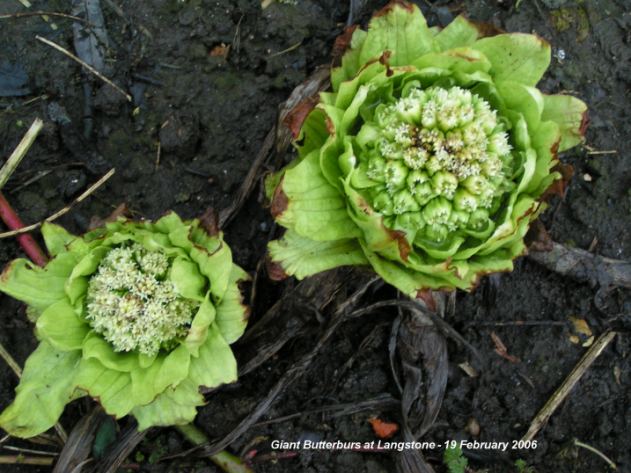
Hedgehog
survey
Caroline French writes
say the People's Trust for Endangered Species are
seeking participants for their 2013 Hedgehog survey -
to record and submit their sightings between 1st Feb
and 31st August. Participants will need to register
online by 1st Feb (it only takes a minute to
register). Go to http://www.hedgehogstreet.org/pages/hibernation-survey.html?dm_i=PAJ,192YS,6IOCDB,48MXI,1
Here is a photo of a
Hedgehog in my garden in June 2010. I remember this
one well as it was a female and had three youngsters
in our garden. That was an exciting first!
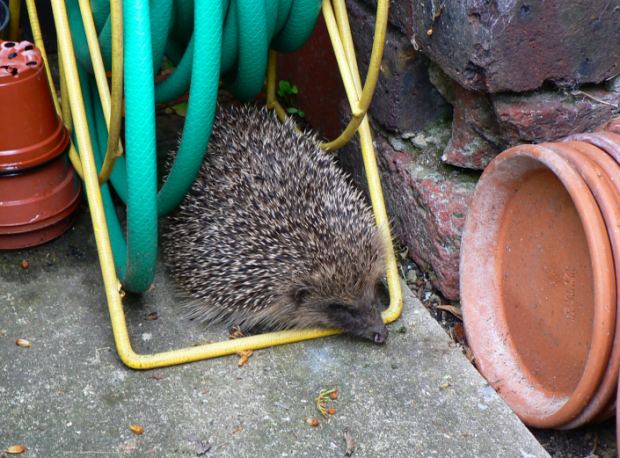
Bullfinch
at Llanelli
Tony Wootton sent me
some great photos that he took during a visit to the
Wildfowl and Wetlands Trust Reserve at Llanelli in
South Wales. They included this splendid male
Bullfinch. Tony said the low tide meant wetland birds
were too far away to photograph.
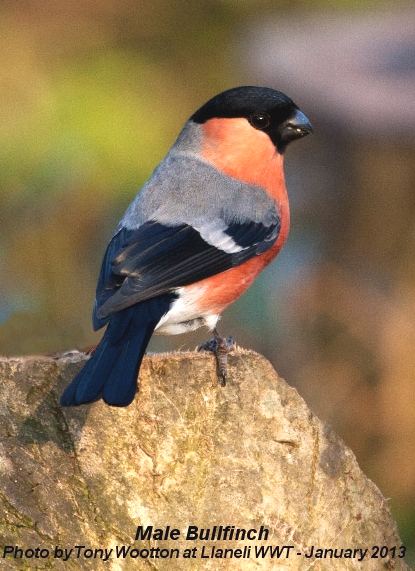
MONDAY
JANUARY 28 - 2013
BROOK
MEADOW
During this morning's
walk through Brook Meadow I met Malcolm Phillips and
Mike Wells near the observation fence, both looking
for Firecrest. Malcolm had a fleeting sighting of it
earlier, but none of us saw it again. No Water Rail
either. Robin Pottinger turned up a little later, but
had no luck either.
Water
Voles
Malcolm and I had more
luck with Water Voles. We both a Water Vole frisking
around at the base of one of the Crack Willow trees on
the flooded west bank of the river in Palmer's Road
Copse south of the Deep Water sign. Later Malcolm saw
a Water Vole on the east bank, not the same animal
that was on the west bank.
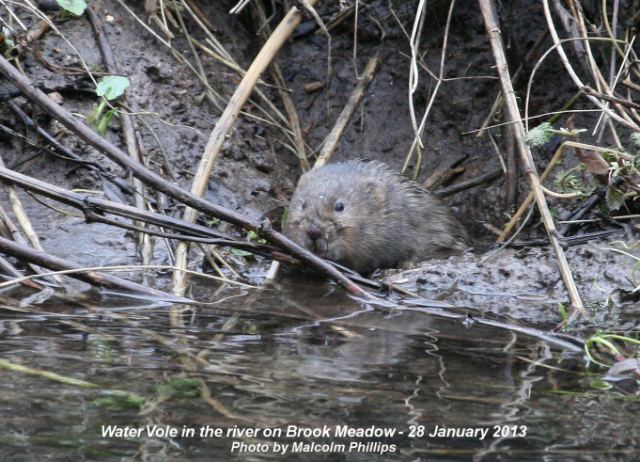
Kestrel
Malcolm spent some
time watching a male Kestrel hunting on the meadow,
probably the same one that he had photographed on Jan
25. He managed to get a few shots of the Kestrel with
its kill including this fine image.

Guelder-rose
berries?
On Sat 26 Jan, when he
was in Palmers Road copse, Ralph Hollins noticed some
bright orange-red berries which he could not identify.
They were near the observation fence, but looking back
towards the car park.
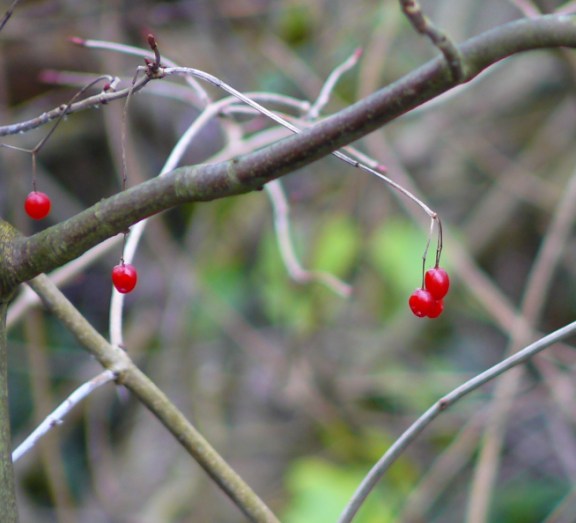
I had a close look at
the berries this morning and discovered they were all
attached by thin stalks to a small single-stemmed tree
growing out of the flooded area west of the main river
path through the copse. The berries were bright red
and soft, containing red fluid and a single flattened
oval seed. My guess is Guelder-rose with most of the
berries off. Ralph agrees.
Butterbur
The pink buds of
Butterbur are now pushing through the main path
near opposite the observation fence. I wonder how many
flower spikes we shall have this year. The last four
years have been very good.
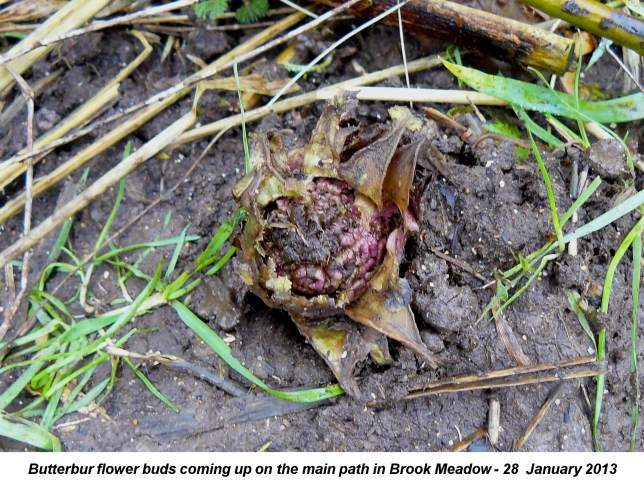
Jew's
Ear fungus
There is a fresh
growth Jew's Ear fungus (now called Jelly Ear) on an
old Elder tree in Palmer's Road Copse, on the other
side of the path from the observation fence, first
seen by Malcolm.
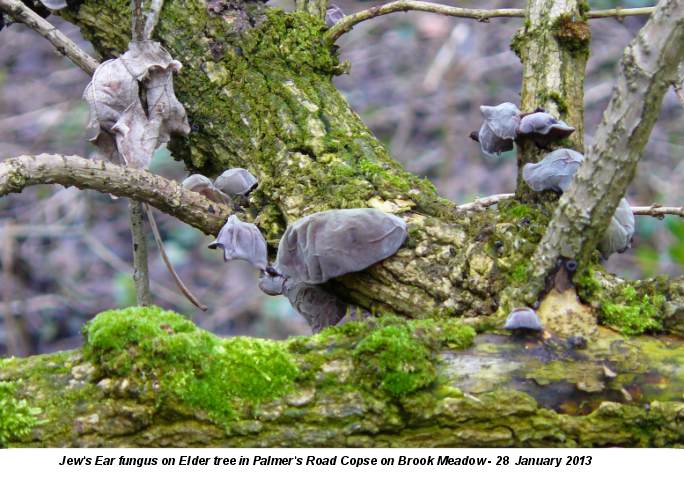
FIRECRESTS
IN HAVANT
Martin Hampton replied
to my query (in the Brook Meadow Conservation Group
e-mail newsletter) regarding the possibility of future
breeding Firecrests on Brook Meadow to say that a pair
held territory last year in back gardens in his road
in south Havant (adjacent to the HB trail). Maybe they
are not so rare as I first thought!
Martin says, "It was a
grand thing to see and hear what I guess must be the
male so often in the spring, and I carried on seeing
birds occasionally in the summer and autumn (though
autumn and wintering birds may have augmented - I'm
never sure of course!). Both here at home and in other
Hants and Sussex sites where I saw so many more
Firecrests last year than ever before - Petersfield
and Sheet, Harting Hill, the Stoughton / Walderton /
Chilgrove area - I have noticed that Ivy-covered
trunks and mature Hollies are often present. Here in
Havant both are in the area where the Firecrests
probably nested last year, but the probable nest site
was in mature specimens of the dreaded Leylandii. I
have started to think of Firecrests as the 'Holly and
Ivy' birds."
OTHER
NEWS
Song
Thrush diet
Brendan Gibb-Gray
asks, how do we attract Song Thrushes into gardens at
this time of year? I don't think there is much we can
do as they do not take the usual seeds, peanuts, fat
balls, etc that are put out for other birds. However,
they do like snails if you have a supply handy. Their
diet is mainly invertebrates (insects, earthworms and
snails) though they do take fruit in autumn and
winter.
Fieldfare
at Prinsted
Romney Turner
re-visited Prinsted yesterday and found Fieldfares
were enjoying the flooded fields.
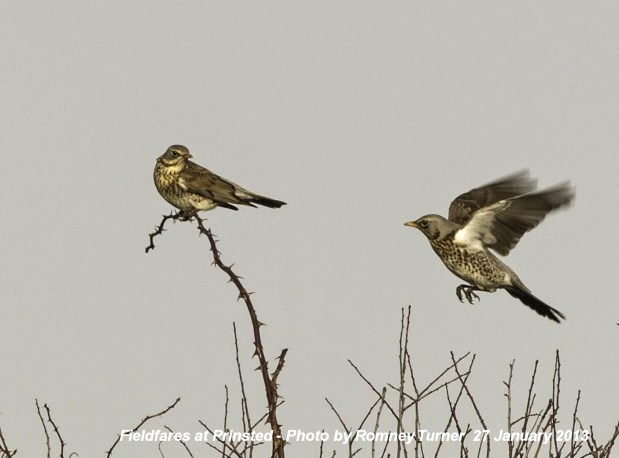
Redshank
at Prinsted
There were also
Starlings in good numbers and plenty of Brent Geese
flying around and Curlews with them taking advantage
of the 'safety in numbers'. Romney also got this
excellent image of a Common Redshank - a bird
that is too often overlooked by avid photographers.
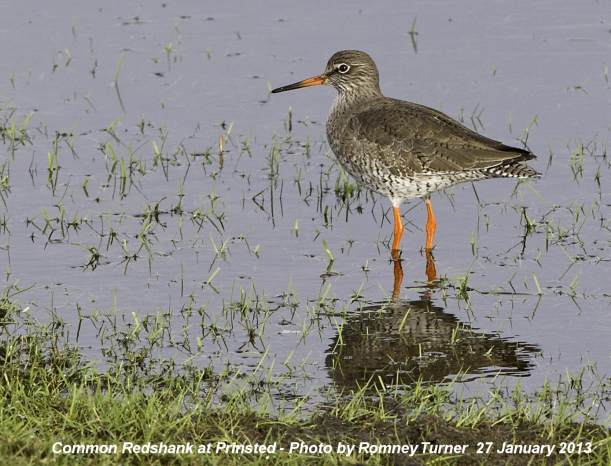
That
Spotted Redshank!
This morning at
10:30am on a very high incoming tide, Peter
Milinets-Raby did his now regular walk from Nore Barn
along the foreshore passing Conigar Point, inland
along Pook Lane and then back along the Solent Way
passing Warblington Church.
"The Spotted Redshank
was performing down to TWO metres - utterly incredible
(mind you there was not a dog walker in sight for the
10 minutes I had the bird until it went off to roost).
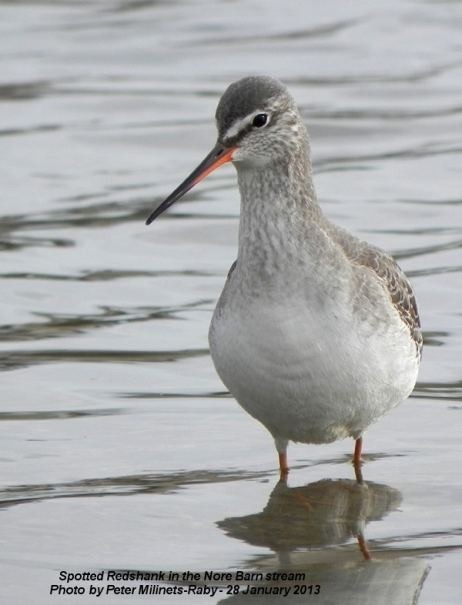
Other highlights
were:
95 Wigeon at Nore
Barn; 132 at Conigar Point and 45 at Pook Lane,
390 Brent Geese at Nore Barn; 146 at Conigar Point and
112 at Pook Lane
230+ Teal at Nore Barn and 130+ at Conigar Point.
Greenshank roosting in field with the pond - 3 Rock
Pipits in here, plus a Snipe and single Teal.
Reed Bunting in the next field along with 2
Skylark.
24 Oystercatcher in the field by the cemetery.
7 Little Egrets together in the field next to the barn
along Pook lane.
450+ Fieldfare in the fields by Pook Lane with 60+
Redwing (Looked about the same number as my last
visit).
45 Curlew in the big muddy stubble field after the
church - 2 Whimbrel in amongst them.
SUNDAY
JANUARY 27 - 2013
Malcolm
Phillips waits
Jean and I walked
through Brook Meadow where we found Malcolm Phillips
in his regular spot behind the observation fence
watching for Firecrest. Surprisingly, he did not see
one at all today.
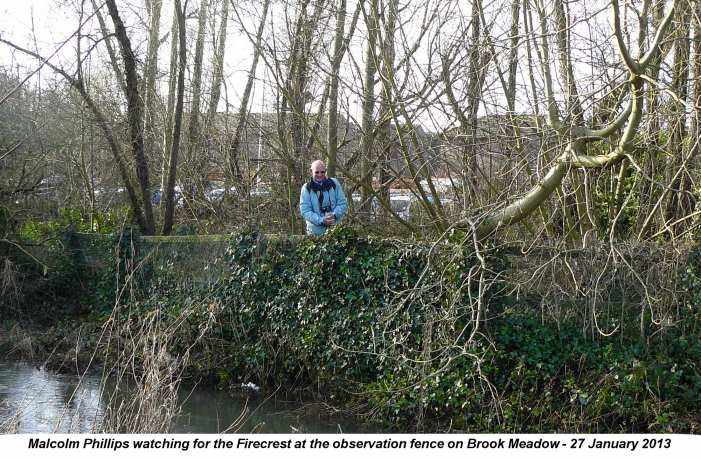
Great
Black-backed Gulls
We walked down to
Emsworth Marina via Slipper Millpond where the pair of
Great Black-backed Gulls were on their nesting raft in
the centre of the pond with three Cormorants. They
have been regular visitors this winter and are clearly
intending nesting there again this year.
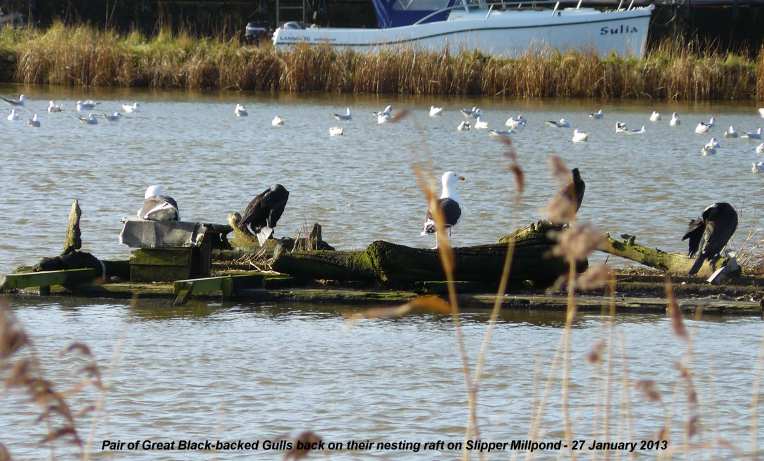
Water
Vole
I returned to Palmer's
Road Copse at about 12 o'clock where I found Malcolm
Phillips still poised with his long lensed camera, but
with very little to shoot. However, at about 12.15 we
did see a Water Vole for about a minute on the east
bank of the river in Palmer's Road Copse behind the
'Deep Water' notice before it disappeared into a hole
in the river bank. Here is Malcolm's photo of the
animal.
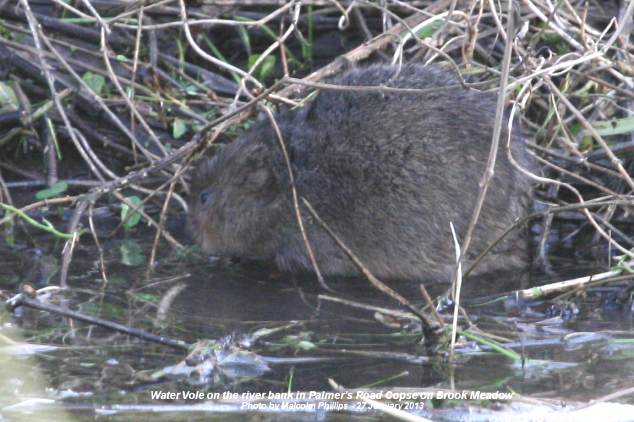
Sanderling
with worm
Tony Wootton got this
unique photo of a Sanderling with a worm at high tide
on the southern tip of Thorney Island. We think it is
a Lugworm. Any other offers?

SATURDAY
JANUARY 26 - 2013
Firecrest
on lichen
Malcolm got his now
regular astounding photo of the Brook Meadow Firecrest
from the observation fence, which I include here not
so much for the bird, as we have lots of Malcolm's
Firecrest photos on this blog, but for the lush growth
of lichen on the branch it is standing on. I don't
know what species it is but it looks a bit like
Physcia aipolia in the books. Can anyone help?
http://www.lichens.lastdragon.org/Physcia_aipolia.html

Wood
Mouse
While Malcolm Phillips
was watching the Firecrest, a slight movement caught
his eye. It was a small mouse only about 3ins and,
from its large eyes and ears in Malcolm's photo, looks
like a Wood Mouse. Interestingly, the mouse in the
photo is gnawing the bark of a small Ash twig, with
signs of more gnawing on the same twig. I looked up
the diet of Wood Mice which is mainly seeds, but also
buds, fruits, nuts, snails, insects, fungi, moss and,
significantly, tree bark. I gather it is not the bark
as such that provides nourishment, but the sugary
flesh beneath. Ref: http://ptes.org/?page=161
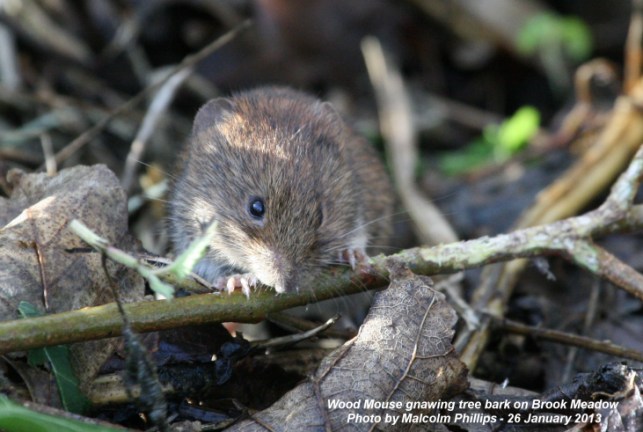
Water
Vole
Malcolm also had yet
another Water Vole sighting from the observation
fence. This takes the total for 2013 to 12. We are of
to a bumper start!

LISA'S
PHOTOS
I was very pleased to
accompany Lisa, my 9 year old granddaughter to Nore
Barn this afternoon to take some photos of the birds
on the shore. Lisa is hoping to enter the Maurice
Broomfield Photographic Competition for local
schoolchildren, organised by the Slipper Millpond
Association. This year's theme for the competition is
'Water and Wildlife' and there is certainly plenty of
both on show at Nore Barn.
We arrived at about
13.30 with the tide falling. Plenty of Brent Geese and
Black-headed Gulls were on the water and as the tide
fell a couple of Black-tailed Godwits appeared along
with the ever faithful Spotted Redshank. It was an
exciting first ever harbour birdwatching experience
for Lisa. She loved seeing the geese on the water and
the elegant godwits. We had to chase around a bit
after the Spotted Redshank which was unusually mobile,
but managed to get reasonably close for Lisa to get
some shots.
I had previously given
Lisa instruction on how to use my 12x zoom Panasonic
Lumix camera and she picked it up very quickly. I
suggested she should take plenty of photos and then
choose the best ones afterwards. Lisa took all the
photos herself and improved as she went on. Hopefully,
she will be inspired to return for more. Here are a
couple of Lisa's favourites.
Black-headed
Gull preening

Spotted
Redshank striding purposively
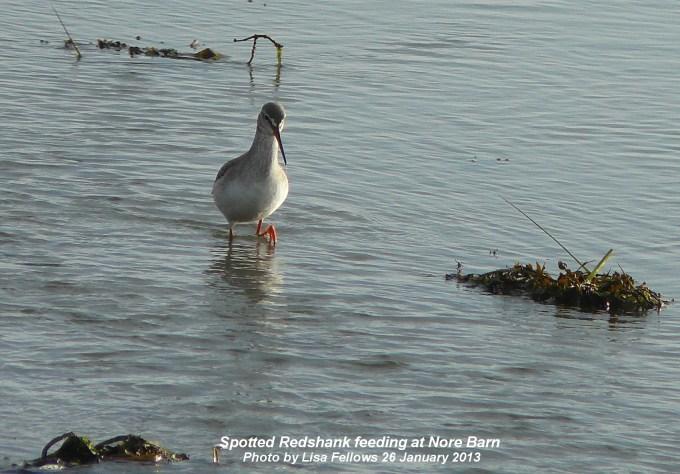
WARBLINGTON
- EMSWORTH
Peter Milinets-Raby
was also at Nore Barn yesterday and got a very close
view of the Spotted Redshank on the last bit of mud
before the tide came in at 9am.
Peter did a circular
walk around the Warblington area from Nore Barn,
walking along the coast (tide pushing in) and cutting
inland along Pook Lane, returning across the fields
past Warblington Church. The other highlights were:
57 Wigeon at Nore
Barn; 99 at Conigar Point; 56 at Pook Lane, 180+ Teal,
4 Gadwall, 8 Pintail, 169 Brent Geese at Nore Barn; 77
at Conigar Point; 110 at Pook Lane, 17 Black-tailed
Godwits, 41 Shelduck, 12 Skylark in the field with the
pond; 26 in the muddy stubble field near church, 3
Woodlark in the same muddy stubble field. 1 Rock
Pipit, 18 Oystercatchers, feeding in the field near
the cemetery and 14 in the field next door. 22 Stock
Doves in this field as well (at least 12 others
elsewhere). 22 Curlew in a field next to Pook Lane, 2
Buzzard, 2 Bullfinch and 2 seen in Nore Barn Wood.
Fieldfare in and around Pook Lane 350 in one field,
210 in another and 47 in another! Redwing in the same
three fields, 36, 37 and 6. 7 Little Egrets in these
three fields, 42 Lapwing in one of these fields, 2
Great Spotted Woodpeckers.
Peter called in
briefly at the observation area in Palmer's Road Copse
on Brook Meadow at 11:30am and saw the Firecrest three
times in an hour (and the ever-present
Malcolm).
Wigeon
at Nore Barn
Here
is Peter's image of a small number of male and female
Wigeon at Nore Barn.
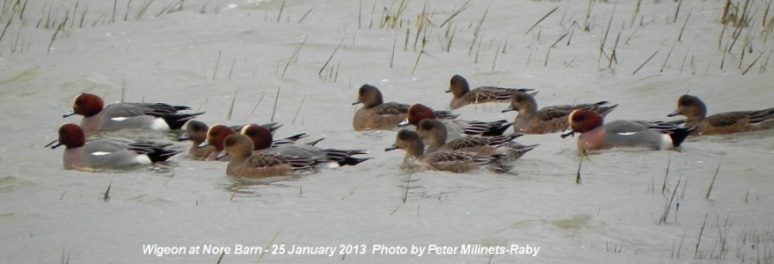
FRIDAY
JANUARY 25 - 2013
Water
Rail
Malcolm Phillips was
on Brook Meadow by 10.30am today and was very pleased
to find the Water Rail feeding by the observation
fence. At first it was part hidden by the brambles but
slowly moved into the open. Malcolm watched the rail
for about 30mins before it moved up river.

Brown
Rat
Malcolm then saw what
at first he thought was a Water Vole in the reeds
opposite the observation fence, but unfortunately it
was another Brown Rat. This one had found a quarter
apple which it was eating.
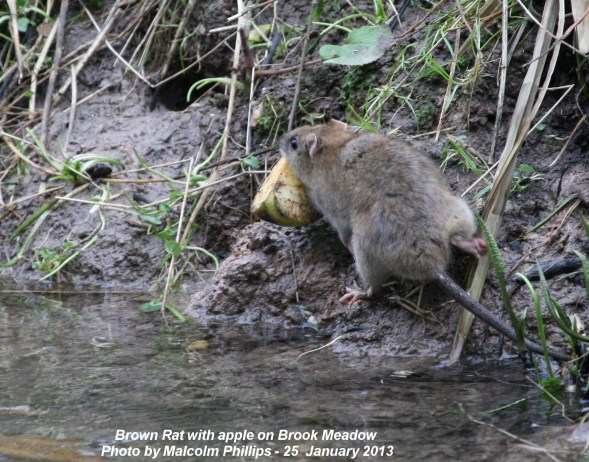
Presumably someone had
tossed the apple into the river for the Water Voles as
they do love apples. But Rats are also partial to
them! Malcolm saw another two Brown Rats near the
north bridge. This is clearly an active time for rats
searching for food, but fortunately there will be no
young Water Voles for them to prey on at this time.
Firecrest
On a brighter note,
Malcolm found the Firecrest in its favourite spot
below the observation fence and got a nice shot of it
preparing to fly.
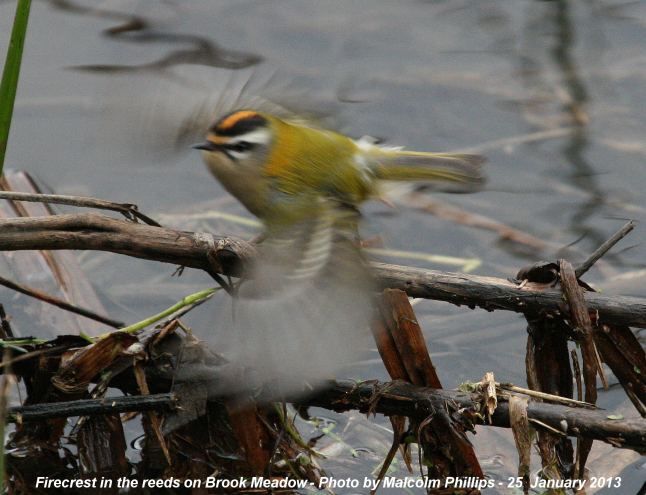
Kestrel
Finally, Malcolm got a
good image of what is probably our local male Kestrel
(grey head) perched in a tree.
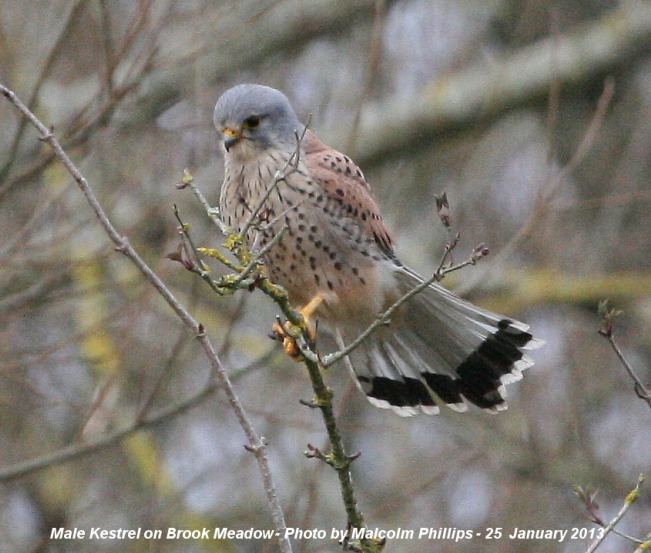
OTHER
EMSWORTH NEWS
Firecrest
in garden
Firecrest is certainly
the bird of the winter on Brook Meadow and now they
are turning up in gardens. No reason why not I
suppose. David Hughes returned from a walk in Brook
Meadow where he saw the photos of the Firecrest in the
signcases and realised that he had one in his back
garden two days ago. David said it was flitting in
amongst the plants/bushes in the garden and came
within 1 metre of his window showing its white
'eyebrows' very clearly. Mill End is east of the
Hermitage Millponds, just off the main A259 road
towards Southbourne.
Tufted
Ducks
Walking round the town
millpond this morning, I counted nine Tufted Ducks, 6
males and 3 females. Maybe, numbers will now start to
build up, but they are late coming in this winter.
Pale-bellied
Brent Geese
Tom Bickerton thinks
the Brent Goose I targeted on yesterday's blog as a
possible Pale-bellied Brent (ssp hrota) is unlikely as
the colour hues are the same as the rest of the flock.
I agree with him, but it was a try. Pale-bellied Brent
Geese - Branta bernicla ssp hrota - breed in Greenland
and NW Canada and migrate mainly to Ireland via
Iceland. They are fairly scarce in the South of
England. They have much lighter bellies than the
Dark-bellied with a clear contrast with the black
breast. See Peter Milinets-Raby photo of one in
Southsea on Jan 7. Peter says it was still there
yesterday (Jan 24) feeding with 681 Brent Geese on St
Helen's Cricket Pitch until 3:30pm at
least.
FIELDFARES
IN SOUTHSEA
Fieldfares are still
around the Portsmouth area in large numbers, but
surprisingly few Redwing. Yesterday (Jan 24), Peter
Milinets-Raby went from Clarence Pier to Eastney and
found a total of 1,067 Fieldfares: 93 on Premier Inn
Pitches; 383 on the common behind Clarence Pier Car
Park; 122 on rest of Southsea Common; 59 on the grass
behind Southsea Castle; 62 on Southsea Tennis Club; 28
on St Helen's Cricket Pitch; 63 on the Pitch &
Putt course; 68 on the Royal Marines Museum; 189 on
Eastney Playing Fields. Only 4 Redwing amongst this
lot, along with 3 Skylark, 11 Mistle Thrush and 7
Lapwing. Kevin Crisp also found another 177 Fieldfare
on Milton Common yesterday.
THORNEY
ISLAND NEWS
Barry Collins reported
yesterday (Jan 24) that the Red-breasted Goose was
feeding in a field adjacent to the footpath leading to
Longmere Point, Thorney Island with ca. 1000
Dark-bellied Brent Geese at 10.30. At 11.40 it was
disturbed by dog walkers and the whole flock flew over
to Pilsey Sands, where they remained until midday
before returning to their former location, only to be
disturbed once again by walkers etc at 12.25. Other
birds of note included ca. 600 Fieldfares on Thorney
Island (but only one Redwing) and a Long-tailed Duck
off Pilsey Island.
ROMNEY'S
PHOTOS
Lapwing
Romney Turner finally
got moving again when the snow thawed a bit and went
for a walk down to Prinsted where she had the pleasure
of seeing lots of Curlew in a snowy field with some
Lapwing and got superb images of both species.

Curlew
Romney
caught the Curlews in flight

Meadow
Pipit in the snow
Romney also came
across a group of Meadow Pipits foraging in the
snow. Suddenly they all scattered and the culprit came
into view, a beautiful Kestrel, but all the pipits
escaped with their lives!
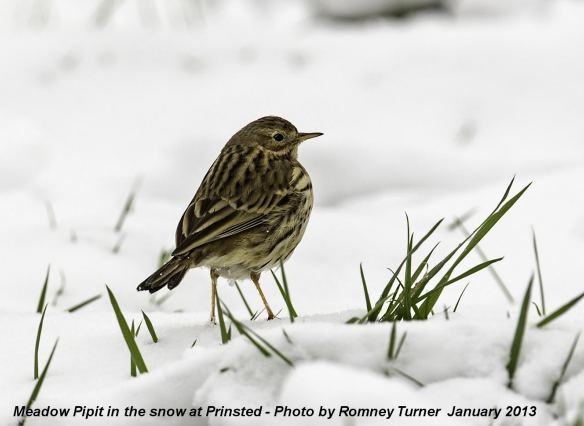
Fallow
Deer in Petworth park
Romney got this
beautiful image of a buck Fallow Deer with magnificent
antlers in Petworth Park The dark-coated deer are
distinctive at Petworth. I could not resist this one.
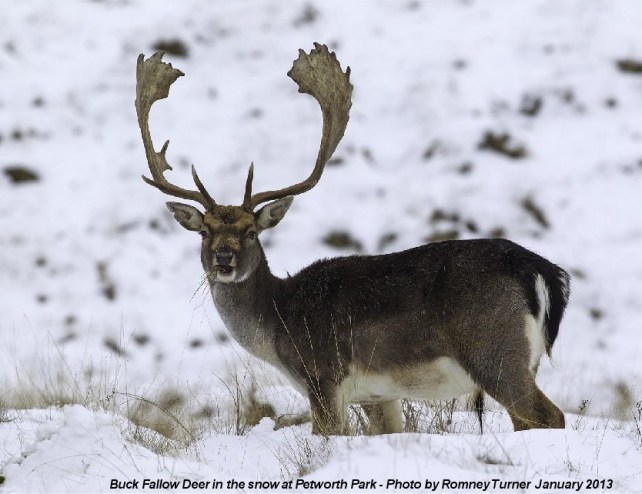
LICHENS
EXPLAINED
As a follow-up to my
piece on the TV programme 'Wild Things' on Jan 22, I
have been reading the book that goes with the Channel
4 series from Amazon. It is very good despite its
glossy appearance and sexy presentation. It has a
particularly clear account of lichens; not a species,
not an organism, not a plant and not an animal, but
rather a way of life! Lichens are made up of at least
two species living in a 'symbiotic' relationship
whereby both partners benefit. One is always a type of
fungus called ascomycete, while the other is usually a
single-celled green algae. The fungus receives sugars
from the algae which in turn gets nutrients and water
from the fungus. So, both benefit from being able to
live in a habitat they would not normally be able to
survive in alone. A subtle adaptation through eons of
evolution.
THURSDAY
JANUARY 24 - 2013
LOCAL
NEWS
I had a late afternoon
walk around Emsworth Millpond where I found 4 male
Tufted Duck. Numbers remain low compared with previous
years. Still no sign of any Red-breasted Merganser.
Yarrow is still flowering on the edge of the millpond
along Bath Road. This takes my January flowering plant
list to 32 species.
Brent
Geese
A small flock of 38
Brent Geese were feeding on the mudflats to the west
of the Emsworth Sailing Club building. A couple of the
birds had quite pale underparts and I was wondering
how pale they need to be for a Pale-bellied Brent.
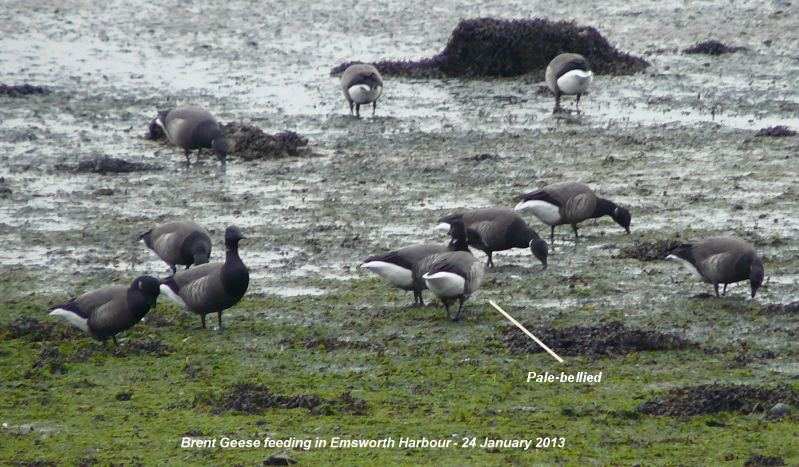
Song
Thrush
Malcolm Phillips went
round the meadow again this morning and stayed for
about 1 1/2 hours. That man has stamina! He was
rewarded with the Firecrest at the usual place
opposite the observation fence. Malcolm then walked to
the north bridge where he saw a Goldcrest and a
Song
Thrush having a bath.
Nice photo.

Back to the
observation fence, Malcolm saw the rats again and
wondered if we can get anything done about them. That
is a long running saga, to which there is no easy
solution. Malcolm did not see any Water Voles or Water
Rail today.
Regarding the Water
Rail seen yesterday, Tom Bickerton thinks it could
well be the same bird that we had previously, but has
remained hidden. Certainly he's not going to let
another rail on the food patch. The image shows a male
and last year's bird was a male too. We know that
waders occupy winter territories so why not this
bird?
Back home to his flat
Malcolm had yet another Firecrest in the garden, plus
Coal Tit and Long-tailed Tits. Malcolm is certainly
the person to follow if you want to see a Firecrest!
I was interested to
read in Mike Wearing's article in the current issue of
the HOS Newsletter 'Kingfisher' that Firecrest is now
established on Butser Hill as a breeding bird. Maybe
that will also happen on Brook Meadow? One can always
live in hope.
Blackcap
in garden
Patrick Murphy also
had some interesting visitors to his garden. They
included a male Blackcap making a couple of fleeting
visits, though Patrick thinks it maybe a different
bird to the regular one as that one used to stay a
long time on the fat balls. This poor fellow is
certainly looking longingly at those fat balls.
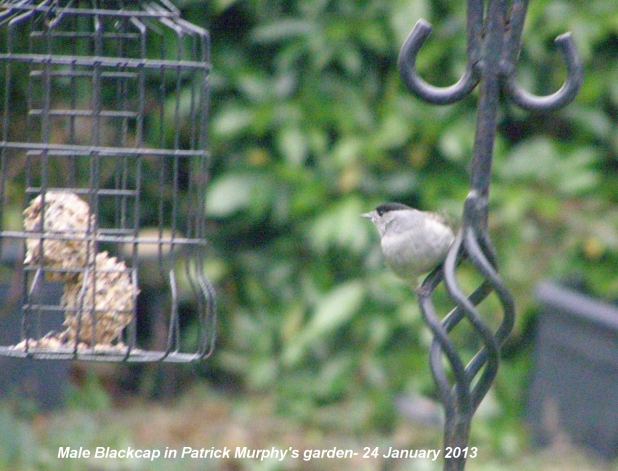
Fieldfare
in Southsea
Graham Petrie went
down to Southsea to have a look at the winter thrushes
that have been gathering all along the seafront. They
were nearly all Fieldfare, a count of 200+ today
(confirmed with scope), the majority of which now
appear to be at the Clarence pier end of the common.
He also saw 2 Mistle Thrush on the pitch and putt
field mixed in with 50-60 Fieldfare, but no Redwings
at all. Fantastic views of them pulling worms out of
the ground.
WEDNESDAY
JANUARY 23 - 2013
NORE
BARN
11:30 - 12:30 - I
spent an hour at Nore Barn about 3 hours after high
water. The weather was dull and chilly.
Gadwall
at Nore Barn
There were masses of
ducks and Brent Geese milling around when I arrived,
more than I recall seeing all winter. A quick count
gave me 400 Brent Geese (including those on the main
western mudflats), 250 Wigeon and 250 Teal. I also saw
4 Pintail and 4 Gadwall with equal numbers of
males and females. These were the first Gadwall I
recall having seen in the Nore Barn area.
Here
is my shot of male and female Gadwall with female at
the front.
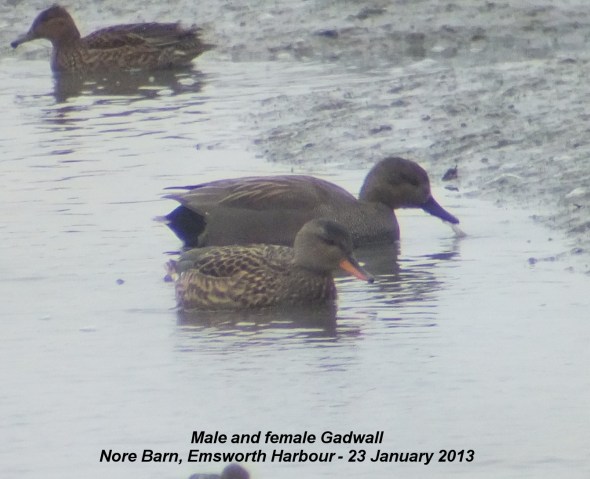
Spotted
Redshank
The Spotted Redshank
was feeding along the seaweed shore at the end of
Warblington Road all the time I was there. For part of
the time it was feeding with 3 Turnstone. There was no
sign of the second Spotted Redshank or the Greenshank
anywhere.
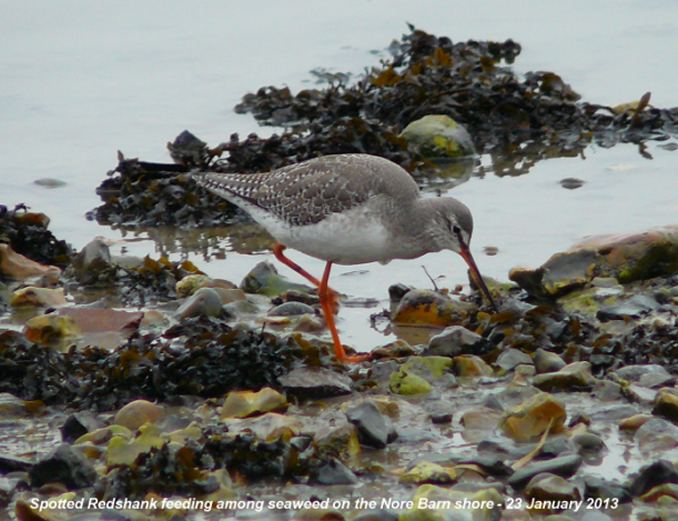
Black-tailed
Godwits
Godwit numbers remain
low in the harbour with only 22 counted today at Nore
Barn. They included one colour-ringed bird, WO+LO flag
which has been fairly regular here this winter. Other
waders in the area included about 20 Oystercatchers,
plus small numbers of Dunlin, Curlew and Grey Plover.
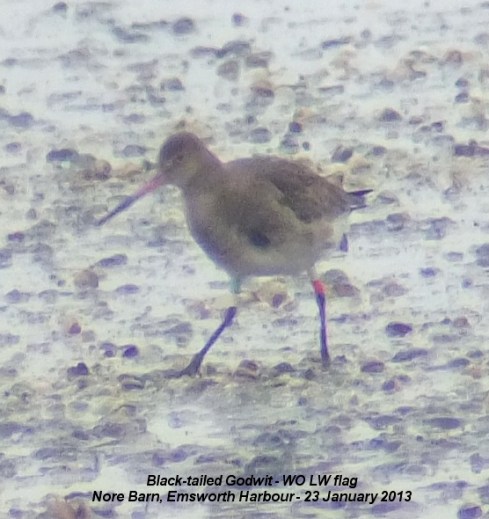
Firecrest
Malcolm Phillips spent
2 and a half hours on the meadow today from 11.45am to
2.15pm looking for birds to photograph. His patience
certainly paid off as he saw not only the Firecrest,
but also the elusive Water Rail.
Malcolm saw and got an
excellent photo of a male Firecrest in a favourite
spot in the reeds by the observation fence. Only the
male Firecrest has orange on its crown, the female has
a yellow crest.
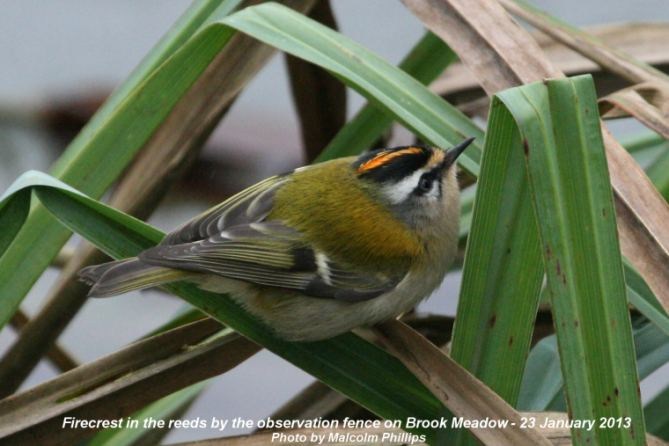
This was the 16th
sighting we have had of a Firecrest on the river in
Brook Meadow since Jan 3. Most of the sightings have
been near the observation fence, but it has also been
seen by the north bridge and by the south bridge and
at various locations on the river between the two
bridges. We are still undecided as to how many
Firecrests there are on the meadow. There may have
been two at one stage, but probably now there is only
one.
Water
Rail
Malcolm was delighted
to find the Water Rail, which he last had a fleeting
glimpse of (and no photo) on Jan 18. This time he saw
it in the bushes just south of the observation fence
and he managed a decent photo.
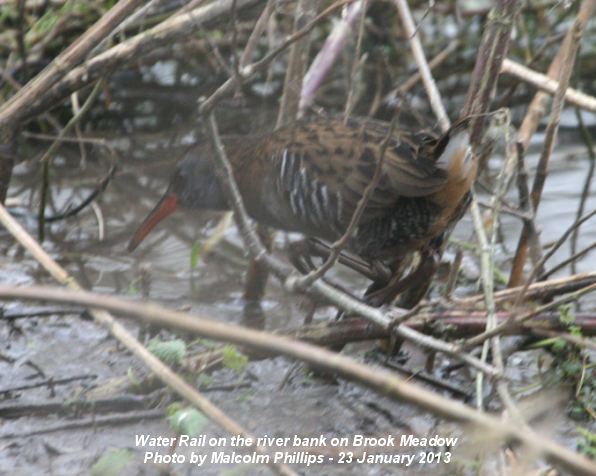
This could have been
the same bird that Malcolm photographed on 18 Dec
2012, as it was in the same area. However, since we
have had no further sightings of it since that date,
despite a lot of looking, I suspect the bird seen
today (and on Jan 18) was another individual.
Brown
Rats
We have had several
sightings of Brown Rats over the past week,
particularly in the area between the sluice gate and
the S-bend. Malcolm saw two individuals today, one was
grey/ brown the other about 2/3rds the size and all
grey. Here is one of the creatures. Note its large
ears, quite unlike those of a Water Vole.
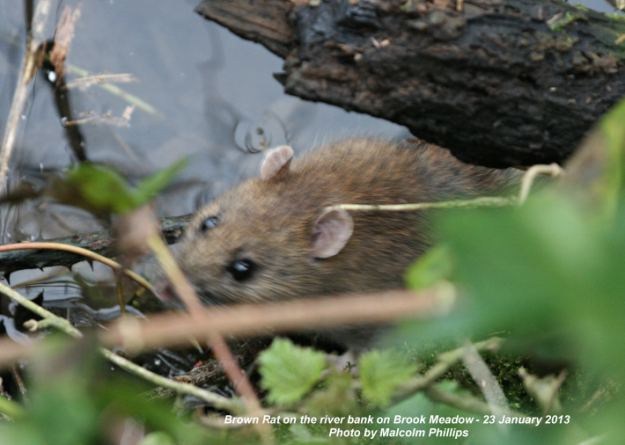
SANDY
POINT
I am grateful to
Juliet Walker for providing the following link to Andy
Johnson's very comprehensive report on the birds of
the Sandy Point area on Hayling Island for 2012.
http://www.hisc.co.uk/2012_Sandy_Point_Report.pdf
TUESDAY
JANUARY 22 - 2013
Goldfinches
in garden
What with really nasty
weather and having a tooth extracted, I did not feel
up to going out today. The birds also were not in the
garden in the numbers they were yesterday, but the
Brambling was here again and the usual collection of
Goldfinches were on the sunflower heart
feeders.
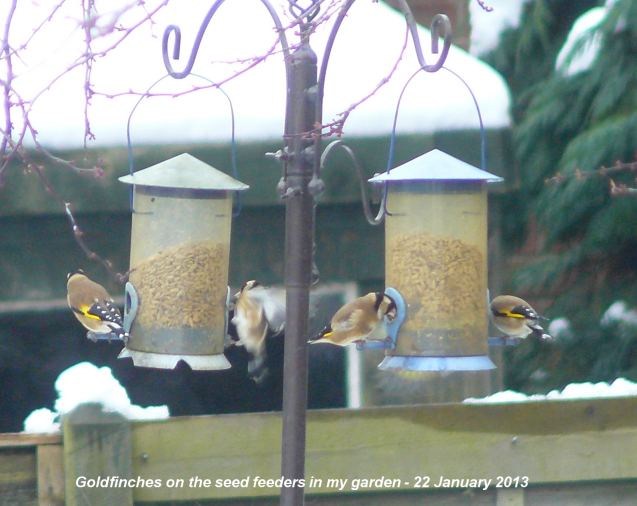
Green
Woodpecker
Patrick Murphy had a
visit this morning from a Green Woodpecker that was
searching among some rotting tree trunks for insects.
Patrick has not seen the male Blackcap for a few days,
which was a regular visitor to the fat balls and spent
a lot of time on them.
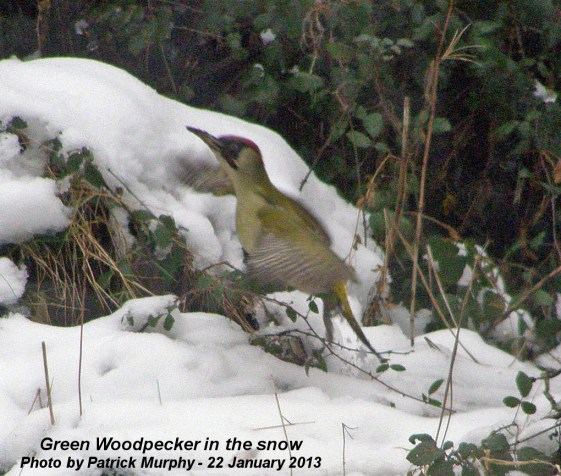
Fieldfares
galore
Thousands of
Fieldfares have been reported over Hampshire and
Sussex today. These birds will very likely be heading
across the channel where hopefully they might find
some food.
See Hampshire Bird
News site . . http://www.goingbirding.co.uk/hants/birdnews.asp
and the SOS Sightings . . http://www.sos.org.uk/index.php?option=com_jobline4&Itemid=10
Local sightings. Bob
Chapman had approximately 500 Fieldfare on the fields
of Farlington Marshes; not a common sight here, says
Bob. Peter Milinets-Raby saw a total of 235 Fieldfare
in and around the Southsea area today - 37 on St
Helen's Cricket Pitch, 70 on Pitch & Putt Course,
12 on Royal Marines Museum and 116 on Eastney Playing
Fields. Peter also had 9 Mistle Thrushes on Eastney
Playing Fields. Meanwhile an estimated 1,000 were seen
on on the Brownwich Cliffs west of Hill Head D Wallace
who commented that they swarmed in large numbers like
Starlings.
One
of Peter's Fieldfares at Eastney

More locally, Martin
Hampton had one Fieldfare feeding on apples in his
Havant garden and Malcolm Phillips saw this rather
forlorn looking Fieldfare in the snow on a walk from
Emsworth to Westbourne this morning.
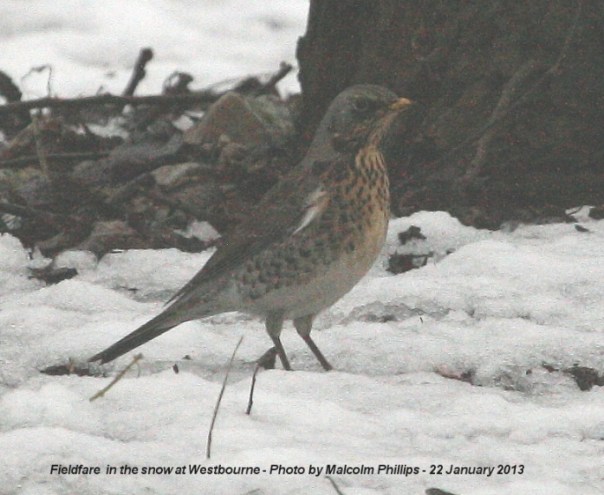
WILD
THINGS - Channel 4 TV Series
Last night (8.30pm on
Monday 21st Jan), I watched the first of what looks
like an interesting new 6 part series on Channel 4
called 'Wild Things' produced by Plantlife people. If
you can put up with the adverts and the rather crass
presentation the programme is well worth watching
again. The show is presented by Chris Myers, a
landscape designer from Yorkshire, Plantlife's Dr
Trevor Dines as expert botanist, and Sally Eaton
(Edinburgh Botanic Garden and formerly Plantlife) as
expert lichenologist.
Danish
Scurvygrass
There was a good piece
about the spread of Danish Scurvygrass
(Cochlearia danica) along the motorways encouraged by
salt spreading and seeds dispersed by traffic. We have
a good growth of Danish Scurvygrass along the northern
edge of the Havant Road east of the Warblington
roundabout. This is the tiny white flowers you can see
by the kerb.
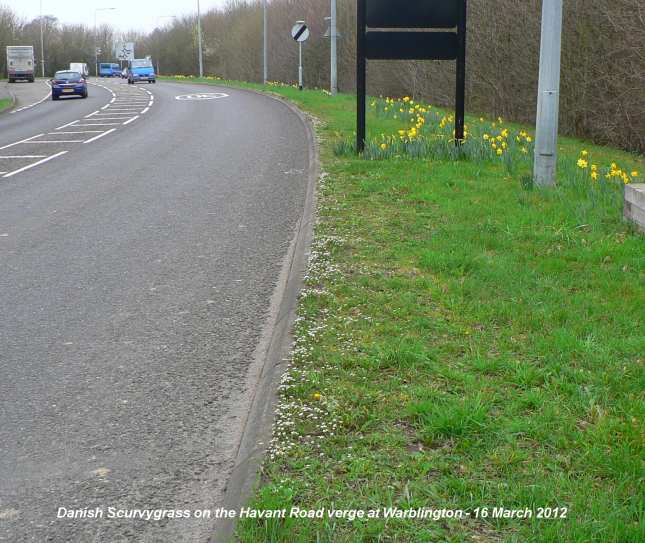
There was also an
interesting piece on last night's programme on
Bluebells and how the hybrid between the
aromatic native Bluebell and the non-aromatic Spanish
Bluebell is spreading.
'Pollution
lichen'
Most interesting was
the story of the lichen Lecanora
conizaeoides which started off by being one of
the rarist species in Britain, then became one of the
most common and now has become one of the rarist
again. This lichen has a layer of crystals that keep
the water out and thus make it resistant to air
pollution. Thus, it thrived during the bad old days
when acid rain was a problem. However, with the clean
up of our air, other lichens which were damaged by
acid rain are now taking over and Lecanora
conizaeoides is in decline. It is sometimes called
'Pollution lichen'.

I have always assumed
from my early reading of John Wyndham's novel 'Trouble
with lichen' that all lichens were vulnerable to air
pollution, but apparently not.
I hightly recommend
looking at the recording of the programme which can be
stopped at critical points . . . http://www.channel4.com/programmes/wild-things/4od
A book, 'The Wild
Things Guide to the Changing Plants of the British
Isles' complete with maps, illustrations and more
background information, has been written to accompany
the series.
MONDAY
JANUARY 21 - 2013
Firecrest
is still here
I had a walk around
Brook Meadow this morning and met up with Malcolm
Phillips, who seems to live on the meadow! He had not
seen much before we met, but after half an hour or so
we had seen Firecrest and Grey Wagtail
in the reeds below the observation fence. Here is
my best photo of the Firecrest that Malcolm and I saw.
Malcolm had a better picture, but I thought I would
slip one of mine in for a change. At least, you can
see what it is.
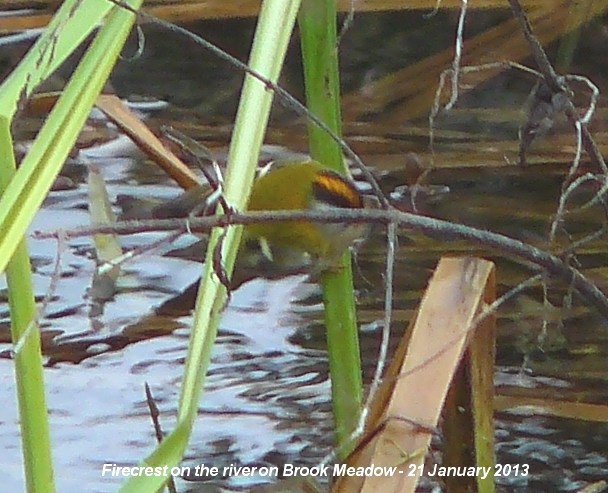
Snow
on Brook Meadow
I went for a walk on
the main meadow where I stopped to admire many of the
plants that were still standing despite carrying a
good weight of snow on their flowerheads. Here is what
I think is a Wild Angelica umbel full of snow.
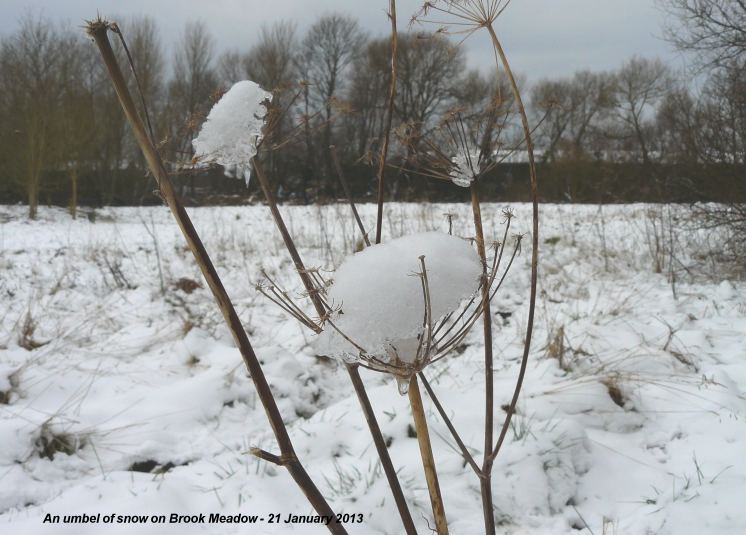
Pied
Wagtail on pavement
After I had left,
Malcolm went into town for a cup of coffee and found
this Pied Wagtail walking along the pavement.
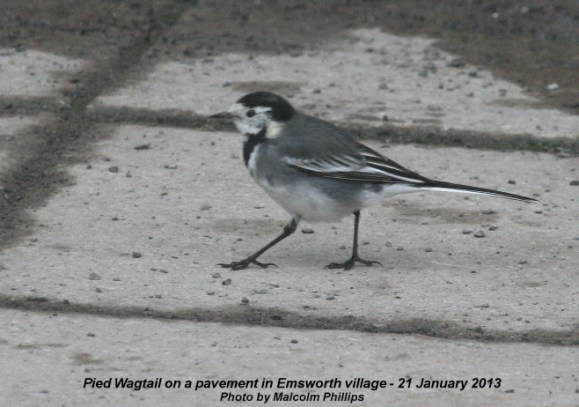
Blue
Tit on fat ball on Brook Meadow
Back in Palmer's Road
Copse, Malcolm hung a fat ball in the tree by the
observation fence, which immediately attracted both
Blue Tit and Great Tit.

Reed
Bunting on Peter Pond
Malcolm also got this
nice photo of a female Reed Bunting in the reedbeds to
the north of Peter Pond.
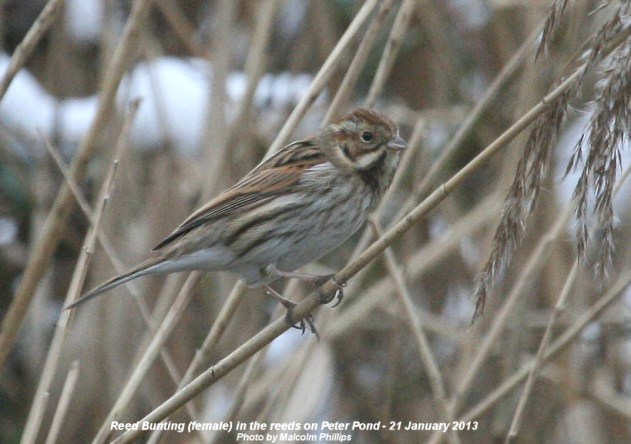
GARDEN
BIRDS
My small garden in the
centre of Emsworth was simply teeming with birds
today, quite an astonishing sight at times. I logged
of 14 species and a total of 58 birds. As the weather
continues to be very cold and snow is still lying on
the ground and bushes, food must be hard to find. It
surprises me that so may birds manage to survive the
night temperatures.
Chaffinches
galore
Chaffinches were
always present whenever I happened to be looking out
of the window, either on the ground, under the shrubs
or on the bird table. Otherwise they would fly up into
a neighbour's Silver Birch tree. They were not easy to
count, but my best estimate would be 30, which is a
record for my garden, beating the 28 in years 2008 and
2003.
Brambling
In with the Chaffinch
flock was a single Brambling, unmistakable with its
white belly contrasting with its bright orange chest
and shoulders. I had my first garden Brambling in Dec
2010, then in Jan 2011, I had up to two birds 4 weeks
running. This was the first of this winter.
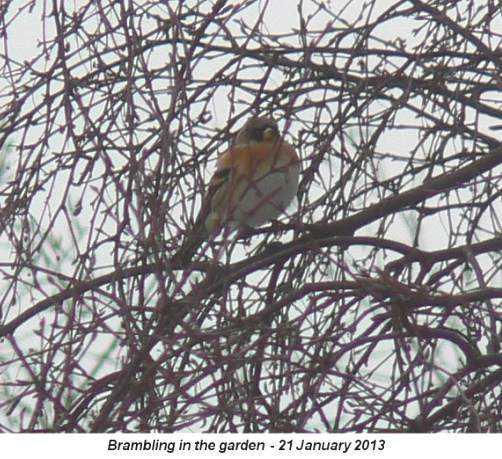
Blackcaps
After writing in
yesterday's blog that I had only seen a female
Blackcap in the garden this winter, well, as so often
happens, I also had a male in the garden today. I saw
the female several times, always feeding on the apples
I had pinned to the tree. The male Blackcap, in
contrast, seemed very nervous. It made a couple of
visits to the bird table which had mixed seed and
chopped peanuts on it, but flew off each time when it
spotted movement behind the window. On one occasion, I
noticed the female Blackcap chasing off the male
Blackcap, though as I have said before I have never
seen any aggression towards other species.
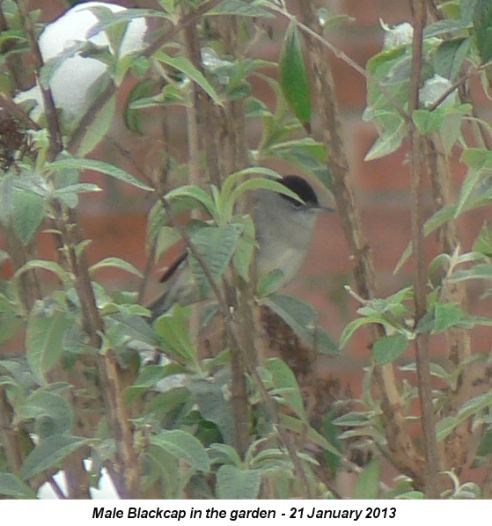
Other
garden birds
Other birds of special
interest for me were 2 Greenfinches, a Coal Tit and a
Starling, all fairly scarce birds in my garden. The
Starling stayed for some while in the tree looking
down at the bird table stocked with food, but never
bucked up enough courage to come down. They really
need safety in numbers.
I saw no sign of the
Redwing or Fieldfare that I had briefly last week,
even though there seems to be a wave of them passing
through our area at present on the hunt for food.
SUNDAY
JANUARY 20 - 2013
Wrens
on Brook Meadow
I had a walk around
Brook Meadow this morning without seeing a great deal;
certainly no sign of Firecrest or Water Vole. I met up
with Malcolm Phillips in Palmer's Road Copse and he
too had seen little apart from the usual suspects,
like Wren, Robin, Dunnock, etc. Here is Malcolm's
photo of one of the many Wrens that can be seen
foraging for insects along the edges of the river.
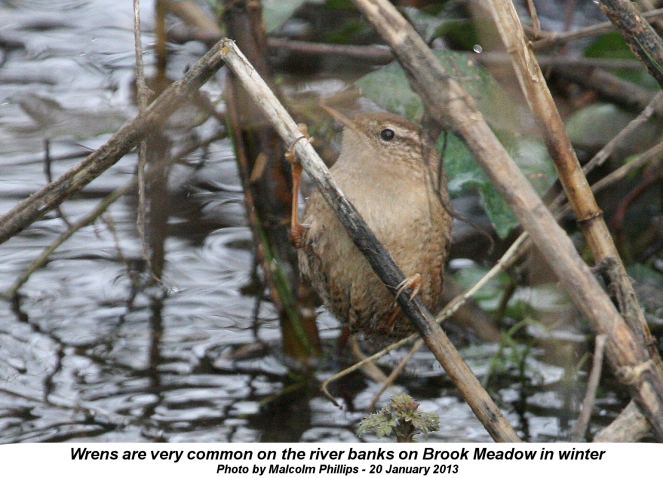
However, I have
received reports from two ladies who visited the
meadow this afternoon and who both had really exciting
experiences, seeing Firecrest, Grey Wagtail and Water
Vole among others. Their reports are worth reproducing
in full to give the full flavour of their experiences.
The first is from Caroline French a well-known local
birdwatcher and a regular contributor to this blog.
The second report is from Claire Power, whom Caroline
met in Palmer's Road Copse. I used to know Claire's
family when they lived in Westbourne Avenue, though I
have not seen Claire since she was a child.
Caroline's
news
"I went down to Brook
Meadow this afternoon for some fresh air but also
hoping to see a Firecrest, as reported on your
website! When I arrived at Palmers Copse there was a
lady from Westbourne watching a Treecreeper, which she
kindly pointed out to me. She also told me she had
seen a Firecrest and two Goldcrests, a Grey Wagtail,
and a Water Vole around the observation area. Like me,
she had read about the Firecrest(s?) on your website
and may send you her sightings.
I carried on to the
south bridge from where I picked up a single
Firecrest feeding amongst the partially
submerged vegetation on the east bank. I had good
views of it for a few minutes. They are superb little
birds!
As I continued on up
the eastern bank I noticed a Water Vole sitting
on one of the smaller pieces of fallen willow, about
halfway between the observation area and the S-bend,
busily feeding on roots of some kind. This was about
4pm. As I was pointing the vole out to a passing
family, the man of the family noticed a second vole
just two feet from the first. The first vole, in
particular, seemed unperturbed by people and dogs
using the path.
Walking along the
northern section of the Ems I saw and heard a Grey
Wagtail flying northwards, out and away from the
meadow. The signcases look good!"
Claire's
news
"I just wanted to
email to thank you for your blog which inspired me to
go to Brook Meadow today and have a brilliant hour
birdwatching. A lady I met there suggested I e-mail
you my sightings. I parked up at the recycling area in
the car park behind Tesco and walked straight down the
path to the stream. I had been secretly hoping to see
a Firecrest, but was amazed that it was the
first bird I saw! It was moving alongside the stream
in the long grass/reed area - I watched it for about 5
minutes - a beautiful sight.
As it hopped up the
stream out of view a Water Vole came swimming
along upstream. It went into the area of branches
opposite the bit I was watching from, climbed over a
few and then disappeared from sight.
I went down to the
south bridge and looking up I had lovely views of a
Grey Wagtail in the stream, bathing and
generally ferreting around for food. I crossed over
and walked up along the stream to the railway track. I
saw a Goldcrest there, alongside the river
again (the only areas of vegetation uncovered were
alongside the stream). I walked round to Peter Pond
and then back along the stream again.
I was fortunate to see
a Treecreeper on a tree just by the bottom
bridge on the way back, and another Goldcrest
again by the place I saw the Firecrest on the way in.
It was interesting to note that the Goldcrests have a
much more 'darting' movement than the Firecrest,
making them harder to follow with the bins.
I also noticed there
were several Wrens around by the water (I
estimate I saw at least 10 along the stream). As well
as the 'normal' blue tits/great tits/chaffinches etc I
saw a Great Spotted Woodpecker. Also a very large
Brown Rat!
So thank you very much
for your blog - I have never seen a Firecrest or Grey
Wagtail before today and without your blog I would not
have had that great pleasure."
Blue
Tit in nest box
Tony Wootton also went
on a fruitless search for the Firecrest today. But he
did notice this Blue Tit investigating the concrete
nest box in Palmer's Road Copse, just above the Water
Vole signcase. Blue Tits do regularly use this box,
but this is much too early to start nesting.

Fieldfare
in garden
Derek and Heather
Mills were delighted to have a visit from a Fieldfare
to their garden in Portsmouth this lunchtime. Derek
managed to get a nice photo despite the sleet.
Interestingly, I too had one Fieldfare, albeit in a
neighbour's garden, yesterday. They must move around
in singles. I get the impression that flocks are
moving through, probably on their way to France.
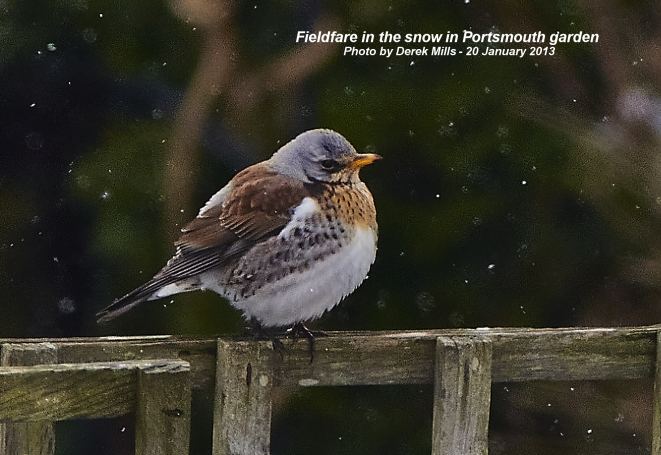
Blackcaps
Caroline French still
has a single regular male Blackcap in her North
Emsworth garden. She completed her BTO Blackcap survey
on Monday. Caroline's Blackcap ate fatballs, kibbled
sunflower hearts and apple. During her half-hour
survey period Caroline saw aggressive behaviour
towards Goldfinches and Blue Tits, which were
sometimes chased away from feeders. The Great Tits on
the other hand saw the Blackcap off (temporarily!),
and the House Sparrows stood their ground.
I have only had a
female Blackcap in my garden this winter and she likes
apples and sunflower hearts, but is never aggressive
towards other birds. A real lady!
Song
Thrushes
Caroline also had
three Song Thrushes in her garden this morning. She
said they expended as much energy in defending 'their'
food source as they gained from the extra provision!
I also had a Song
Thrush in my garden this afternoon (quite an unusual
visitor). It was eating a snail when it was chased off
by a Blackbird, who also finished off the snail. I
find Blackbirds are very aggressive towards Song
Thrushes and will not tolerate their presence in the
garden.
SATURDAY
JANUARY 19 - 2013
Two
Firecrests?
Malcolm Phillips had a
good day round Brook Meadow today. He had two
sightings of a Firecrest, the first at the observation
fence and the second at the north west corner. Malcolm
is fairly sure they were different birds, as the two
sites were about 200 metres apart and Malcolm only
took about 30 minutes moving from one to the other.
The plumage of the two also look slightly different
from the photos.
Here
is Malcolm's first Firecrest

Here
is Malcolm's first Firecrest
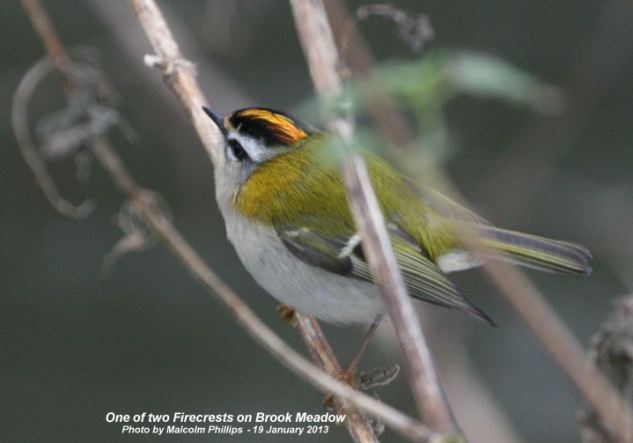
The evidence is now
strong that there are in fact at least two Firecrests
'resident' on Brook Meadow. One Firecrest has been
regularly seen in the Palmer's Road Copse area from
the south bridge to the observation fence (Jan 14, 15,
17, 18, 19). A second Firecrest has been seen further
north along the River Ems as far as the north west
corner where the river bends to go alongside the
railway embankment (Jan 3, 15, 17, 19). A possible
third Firecrest has been seen once on the east side of
Brook Meadow Lumley Stream (Jan 11).
Grey
Wagtail
Malcolm also saw a
Grey Wagtail near the observation fence, which was
probably the same bird that Ros Norton reported seeing
here on Jan 17.
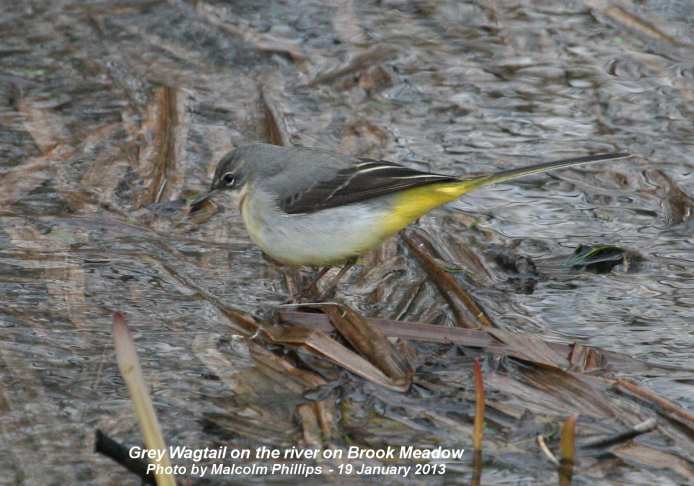
Blue
Tit on Brook Meadow
Malcolm also got this
lovely photo of a Blue Tit which I could not resist.

BTO
SURVEYS
Winter
Thrushes
The graph shows the
total numbers of winter thrushes and Starlings
reported to the British Trust for Ornithology survey
each month since mid September. The figures for
January 2013 are just for the first half of the month,
but are already high because of the extra visits made
during the core midwinter period. The graph shows
surprisingly few Song Thrushes have been recorded in
the survey. This is interesting in view of the flock
of 15 Song Thrushes seen by Peter Milinets-Raby and
John Norton at Warblington on Jan 15. Has anyone else
seen a gathering of Song Thrushes? The graph doesn't
include Mistle thrushes.
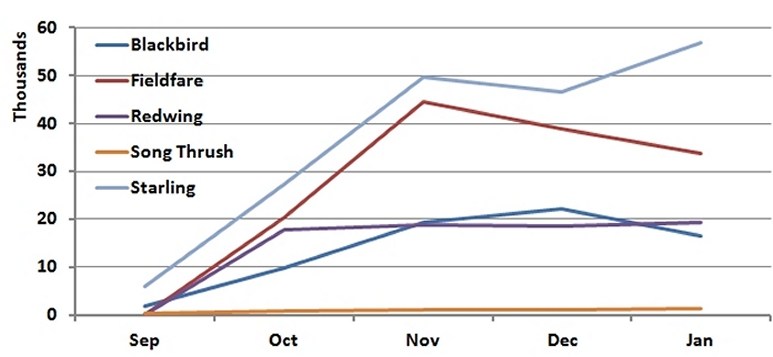
For more information
go to . . . http://www.bto.org/volunteer-surveys/winter-thrushes/latest-news
Garden
Blackcaps
Blackcaps are an
increasingly common sight at garden feeding stations
during winter and are seen most often early in the New
Year. The foods that we provide seem to be having a
profound effect on the ecology of these birds,
changing their migratory patterns and subsequent
nesting habits. The BTO is conducting a survey of
wintering Blackcaps in gardens to discover more about
1) Which foods are Blackcaps eating, 2) numbers of
male and female Blackcaps and 3) any signs of
aggression with other, similar sized birds. This
survey runs during January 2013 only.
In my garden 1)
Blackcap eats sunflower hearts and apple. 2) I have
only had a female Blackcap this winter, though I have
had both sexes in previous winters. 3) I have never
witnessed any aggression towards other species.
For more information
about the survey go to . . . http://www.bto.org/volunteer-surveys/gbw/about/background/projects/garden_blackcap_survey
Nightingale
migration
Until recently, the
only British-ringed Nightingale to be reported in
Africa had only made it as far as Morocco. Support by
volunteer ringers for a project in The Gambia has
changed all that, with the capture of two birds
wearing rings that had been put on in East Anglia. On
average, between 150 and 250 Nightingales are ringed
in Britain each year, with a total of just over 12,000
ringed since 1909. Before the two Gambian recoveries,
only 10 BTO ringed Nightingales had been reported
overseas. The only one reported from outside Europe
was a bird found dead in Morocco in April 1975, on its
way back to England.
Interestingly, these
Gambian birds may still have been on their way south
when caught in The Gambia, especially if the only bird
that we have been able to track is typical. A bird
caught in Norfolk in 2009 and re-caught in 2010 was
able to divulge is movements thanks to the geolocator
it carried on its back for the journey. This
individual spent a month somewhere in Senegambia,
quite possibly in the Gambia itself, from mid-November
to mid-December, before moving south-east to
Guinea.
For more information
go to . . . http://www.bto.org/science/migration/tracking-studies/nightingale-tracking
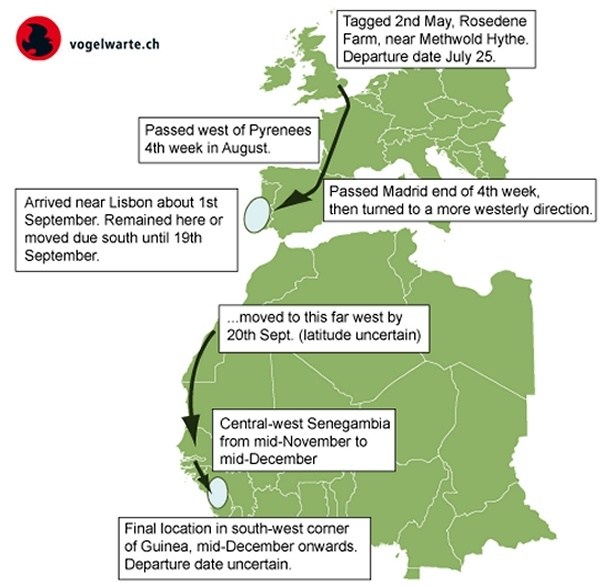
FRIDAY
JANUARY 18 - 2013
EMSWORTH
- Snowfall
In common with other
areas of the south coast, we experienced a fairly
heavy snowfall today. It began in Emsworth in the
early morning and got heavier. It eased of for a
while, then started again and carried on until late
afternoon. I measured a final depth of 4 1/4 inches
(11cm) on our flat patio table, far less than the 7
inches I recorded after the last heavy snowfall we had
in early Dec 2010. Here is a photo of my garden during
the snowfall.
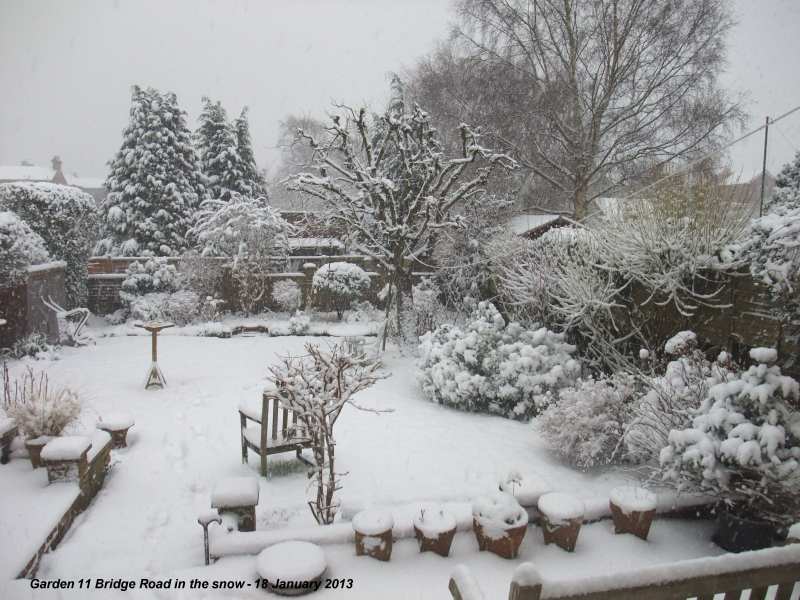
Greenfinch
in garden
I spent much of the
morning watching the birds in the garden. There was
much coming and going of most of the regular garden
visitors, including an unusually large number of 18
Chaffinches. I also had 2 Greenfinches and
a female Blackcap. I kept replenishing the
feeding areas that remained fairly free of snow
beneath the bushes with mixed seed and chopped
peanuts.
It
is good to see Greenfinches back on the feeders
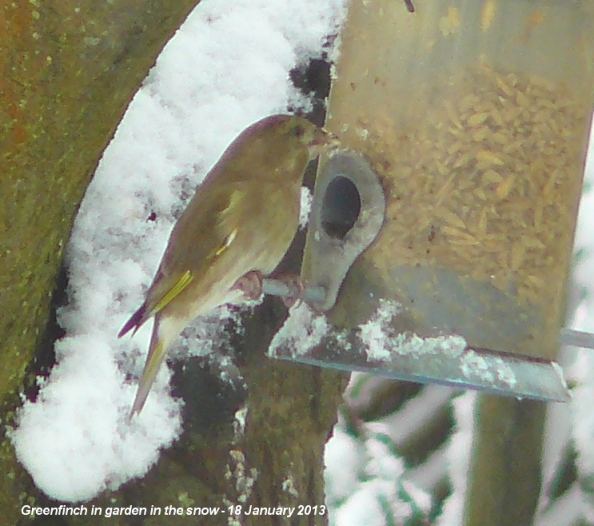
Female
Blackcap
A
female Blackcap has been a regular garden visitor this
winter
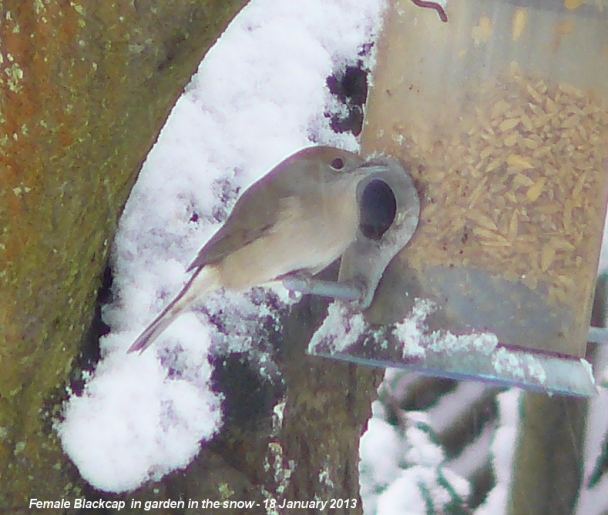
Fieldfare
in gardens
I was pleased to see
my first winter thrushes of the winter. At about 11am
a flock of about 30 Redwing fly in to perch at
the top of the Silver Birch tree in next door's
garden. I recall seeing a similar number in this tree
during the snowfall in Feb 2012. They only stayed for
about 30 seconds and there was no chance of a photos.
However, I did manage to get a digiscoped photo
through the window and the snow of a single
Fieldfare that arrived in another neighbour's
tall tree with a flock of Starlings.
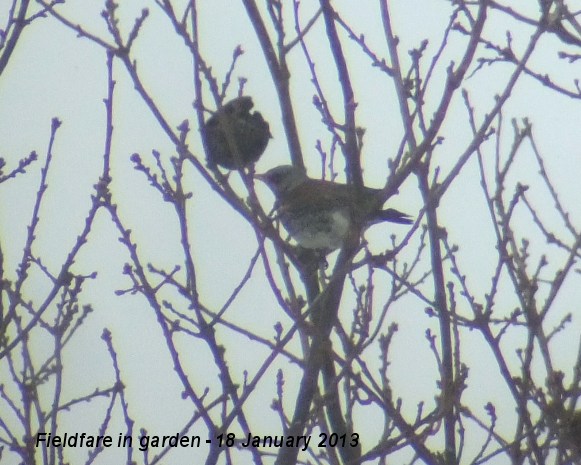
Brook
Meadow snowfall
During a slight lull
in the snowfall this morning, I had a walk around
Brook Meadow which looked very pretty with a layer of
snow covering the bushes and trees.
Here
the Seagull Lane gate entrance to the meadow.
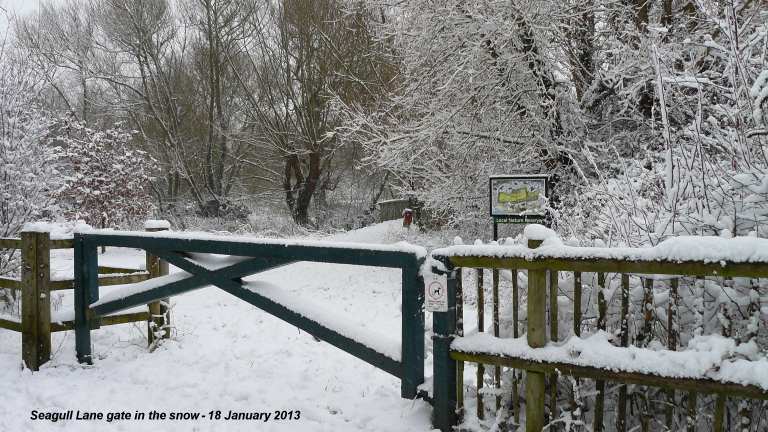
and
the view across the meadow from the observation fence
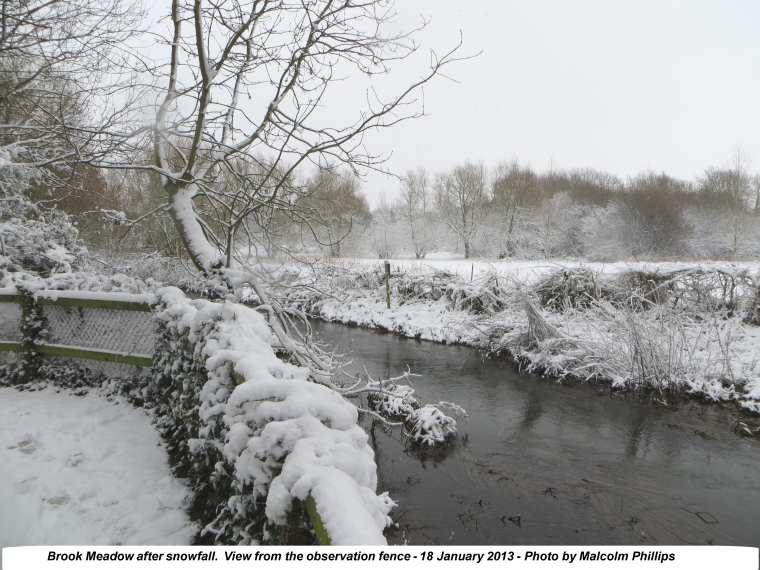
Two
Firecrests
I met up with Malcolm
Phillips who told me he had just seen a pair of
Firecrests on the river bank in Palmer's Road Copse.
The two birds flew in together, but by the time
Malcolm got the camera up and ready they had gone into
the bushes. This is the first time two Firecrests have
been seen together, though we have suspected there
might be more than one as the earlier sightings have
been in quite different areas of the river.
Water
Rail?
Malcolm also thought
he saw a Water Rail by the observation fence. Malcolm
previously saw a Water Rail in this area on 18 Dec
2012, but there was no further sighting of it despie a
good deal of searching. I had a look for it but there
was no sign of the bird. It will be worth keeping a
look out as this could be another bird passing
through.
FINDHORN
NEWS
Richard Somerscocks
sent an up date on a few of his Findhorn sightings
since the last report on Jan 13. Richard's report and
fantastic photos can be seen on the special page of
Findhorn News. They include Bar-tailed Godwit, Knot,
Scottish Crossbill, Grey Seals and a male Long-tailed
Duck. To see them go to . . . Findhorn
News
THURSDAY
JANUARY 17 - 2013
BROOK
MEADOW
Conservation
work session
I went over to Brook
Meadow this morning mainly to take photos of the
regular Thursday work session. We had a group of 11
keen volunteers despite the sub zero temperatures. It
was not possible to continue repairing the raised
paths as the gravel was frozen. So, the main tasks
were clearing dead vegetation from the areas around
the Alder Buckthorn and the Sweet Chestnut saplings on
the south meadow.
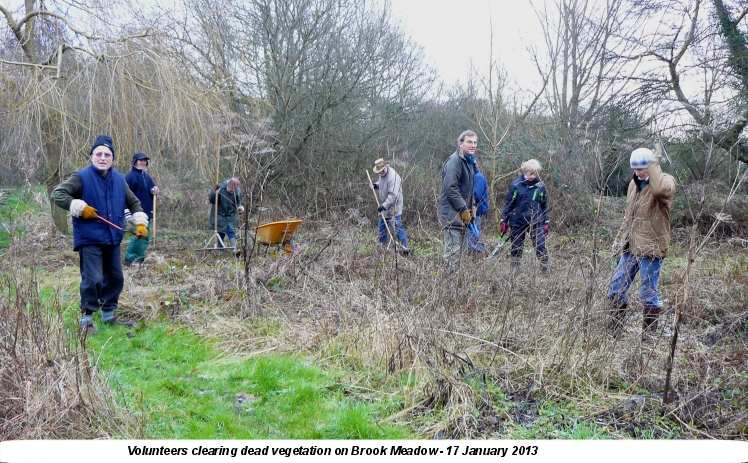
Most of the dead
Hogweed plants were spared for their architectural
beauty, some of the larger ones dwarfing the 6 foot
Maurice Lillie.
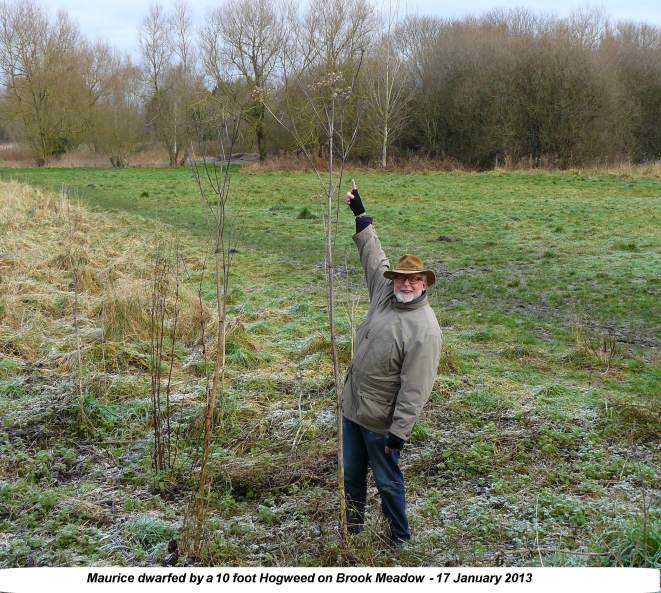
Animals
in a bottle
The volunteer litter
pickers found a beer bottle with two dead animals
trapped inside. They looked like small mice, which had
probably crawled in but were not able to get out again
as the bottle filled up with water.
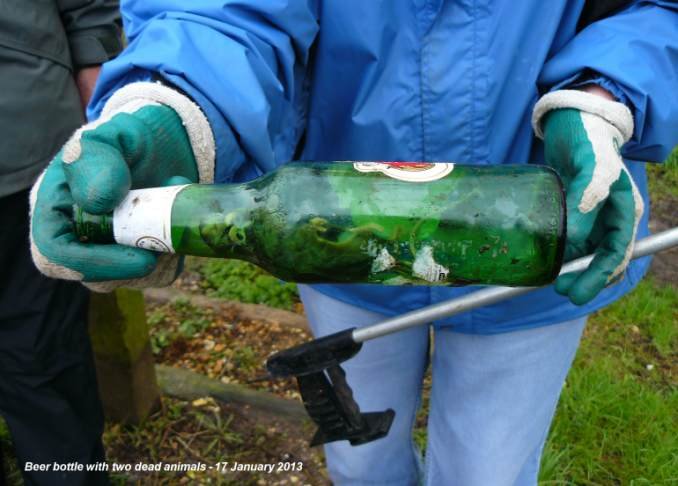
Bird
news
A Song Thrush
was singing strongly in Lumley Road. Wrens were
highly active along the river banks with occasional
bursts of song. Late this afternoon, I heard a short
burst of Blackbird song from a bird perched in
a tree in Bridge Road car park.
At 1pm today Ros
Norton saw a Grey Wagtail fly south to the
south bridge where it stopped briefly before flying
further south.
The
first Snowdrops
The first Snowdrops of
the year on Brook Meadow were showing on the side of
Lumley Road.

For
earlier observations go to . . . January
1-16